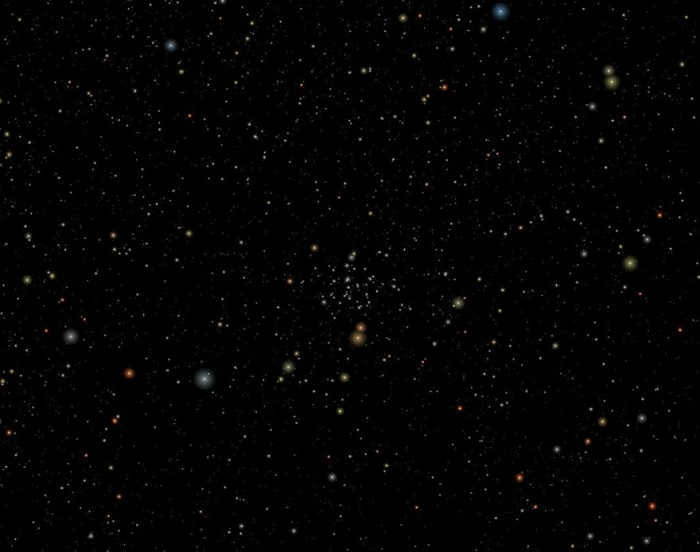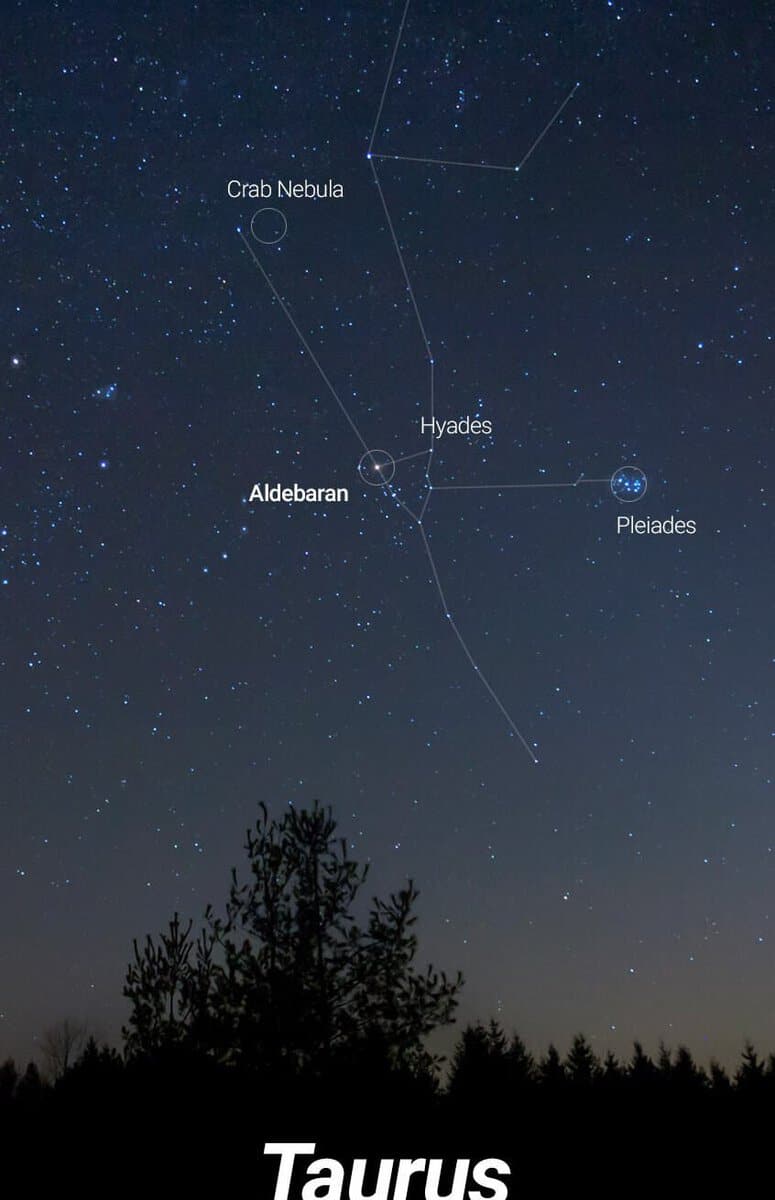


Since ancient times, people have been fascinated by the mesmerizing night sky and have developed a tradition of grouping stars into constellations, assigning them names inspired by mythical creatures and legendary heroes. In a previous article, we explored the constellation Leo, and today we turn our attention to another captivating constellation – Taurus (or Taurus), known for its abundance of stars.
Legend of the Taurus Constellation
The legend surrounding the Taurus constellation dates back to ancient Greece, and there are two variations regarding the identity of this celestial figure, which the observant Greeks were able to discern in the night sky. According to the first version, the Taurus constellation represents the supreme god Zeus, who transformed himself into a majestic bull. In Greek mythology, Zeus was known for his fondness for beautiful women, and on this occasion, he found himself captivated by Europa, the stunning daughter of the Phoenician king. To win her affection, Zeus took the form of a magnificent white bull and joined the king’s herd. The alluring bull caught the attention of Europa, who couldn’t resist the urge to ride him. Little did she know, the bull was actually Zeus in disguise, and as soon as she mounted him, he magically whisked Europa away on his back to the enchanting island of Crete.

Zeus, disguised as a bull, kidnapped Europa.
According to an alternate version, Taurus represents the Cretan bull, which may or may not be the same bull that Zeus transformed into. This bull was defeated by the legendary hero Heracles during his seventh labor. In this sense, the myth of the Taurus constellation mirrors the myth of the Leo constellation, as both the “star Lion” and the “star Taurus” were defeated by the courageous Heracles, who completed his 12 labors.

Nevertheless, it wasn’t just the ancient Greeks who associated this group of stars with a bull. Other civilizations, including the Babylonians, referred to it as the “Heavenly Bull”. As per Babylonian mythology, the vengeful goddess Ishtar dispatched this celestial bull to obliterate a certain hero who had spurned her affection.
The zodiac refers to Taurus. In astronomical geography, it is known as an imaginary ring that surrounds the ecliptic, which is the path of the Sun. The zodiacal belt consists of twelve constellations that lie along the ecliptic in astronomy.
Taurus is the 17th largest constellation in the galaxy, covering an area of 797 square degrees. It is surrounded by Aries to the west and Gemini to the east. Taurus’s neighbors to the north and south are Perseus and Eridanus, which are unrelated to the zodiac.
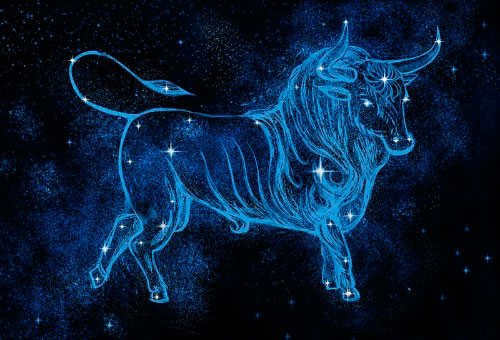
Taurus is traversed by the Sun between May 14 and June 21.
The name Taurus was bestowed upon it by the ancient scholar Eudoxus of Cnidus. According to Greek mythology, Zeus transformed himself into a white bull and abducted Europa, a Phoenician princess. He transported the beautiful maiden across the sea to the island of Crete, where he revealed his divine countenance to her, capturing her heart. Thus, this enchanting tale was adopted by ancient astronomers and given its “celestial” representation.
How to locate the Taurus constellation?
To discover the Taurus constellation, the simplest approach is to locate the brighter and more prominent Orion constellation, which is slightly below and to the left of the “Taurus star”. Intuitively, the Taurus constellation will be situated above and to the right of the Orion constellation. Interestingly, in ancient illustrations, the celestial Orion is depicted as a hunter aiming at the celestial Taurus.
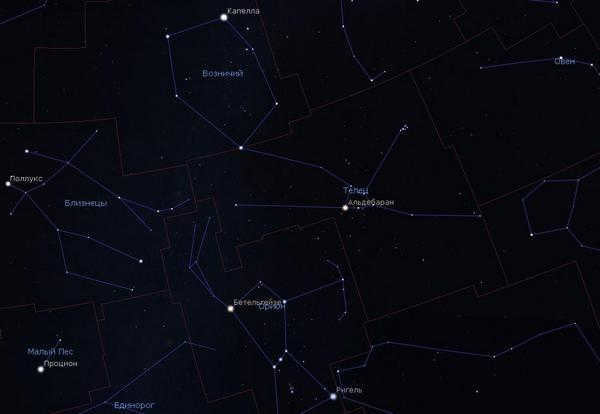
A visual representation of the Taurus constellation is illustrated in the diagram above.
One can easily identify the most prominent star in this constellation, Aldebaran, which possesses a subtle orange hue. As a point of reference, one can draw a line through the three stars of Orion’s belt and continue it to the right, where Aldebaran will be located.
Furthermore, by directing your gaze further to the right and above Aldebaran, you will readily observe the Pleiades star cluster, a captivating and highly visible feature in the night sky.
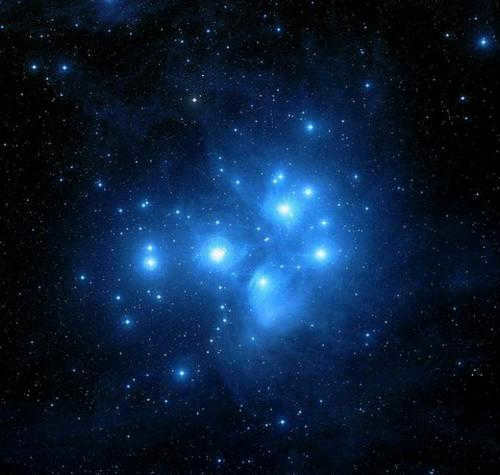
The star cluster known as the Pleiades has a rich history. In ancient times, it was believed to be a constellation attributed to the Greek astronomer Eudoxus. However, it is now believed that Eudoxus was only the first to describe the constellation. The Pleiades is included in Claudius Ptolemy’s famous Almagest catalog of the starry sky.
According to ancient Greek mythology, the Pleiades cluster is associated with the story of Zeus, who transformed into a white bull in order to abduct Europa and bring her to the island of Crete. Another version of the myth claims that the Pleiades represent a bull from Crete that was defeated by Hercules during his seventh feat. It is possible that this bull is the same one that Zeus transformed into. After the bull’s defeat, it was immortalized among the constellations. There is also a version of the myth that connects the name of the Pleiades to the ferocious fire-breathing bulls that Jason tamed in Colchis.
According to Slavic pagan mythology, Veles, the god of cattle, was associated with the Pleiades star cluster in this particular constellation.
The constellation’s Latin name is Taurus, which reflects the Russian word “tur” meaning a primitive bull. However, the commonly used Russian name for this constellation is now “Taurus”.
The primary celestial bodies of the Taurus constellation
There is a vast array of stars within the Taurus constellation, and while we won’t cover all of them, we will focus on the most prominent and luminous ones.
Aldebaran
Aldebaran stands out as the brightest star in this constellation, serving as its alpha. With a luminosity of 0.87m, Aldebaran ranks 13th in terms of brightness among the observable stars in the Universe. As an orange giant, Aldebaran has already reached a considerable age in stellar terms. Currently, it is undergoing helium burning and experiencing significant expansion. Its diameter is 38 times larger than that of the Sun, despite having the same mass.
Aldebaran, which is only 65 light years away from us, is a star with the same mass as our Sun. Interestingly, it emits 150 times more light than our Sun and is considered to be almost our nearest neighbor in galactic standards.
Another interesting fact about Aldebaran is that it is a double star, with a dim red dwarf companion located at a distance of several hundred astronomical units.
Although Aldebaran may appear to be part of the Gliades star cluster, it is actually not related to them. It is simply in the same direction as the Gliads, but the latter are much farther away from us compared to our “stellar neighbor” Aldebaran.
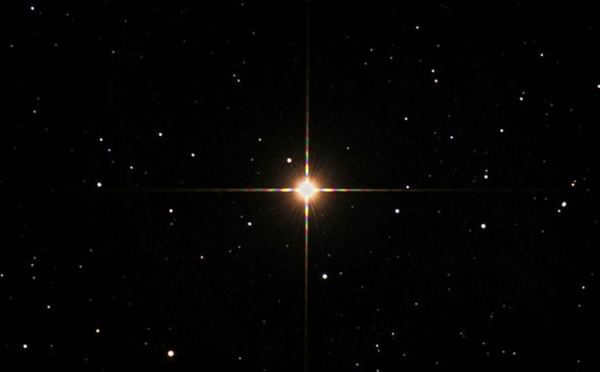
Here are some fascinating details about Aldebaran:
Nath
Nath is the second most luminous star in the Taurus constellation, specifically its beta star. It lies on the border with the Ascendant constellation and was once a part of both constellations. Nath, also known as El-Nat, is located at a distance from us that is twice as far as Aldebaran, measuring 131 light-years. Furthermore, Nath is moving away from us at a rate of 9 kilometers per second. It has a size that is 5-6 times larger than our Sun and is 4.5 times more massive.
Nath is a blue giant and, like Aldebaran, is steadily expanding. Due to its substantial size, it will eventually surpass Aldebaran’s alpha star in both size and brightness. Additionally, Nath is a binary star system.
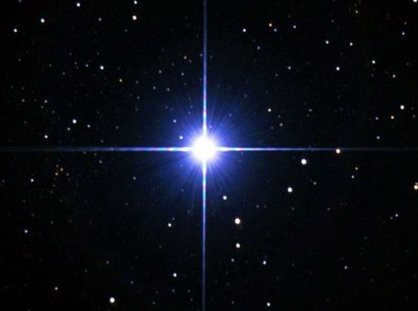
Other unique stars in Taurus
Within the expansive collection of stars in Taurus, there are two that stand out: theta Taurus – Alcyone and zeta Taurus (unnamed).
Alcyone is an extraordinary star within the Pleiades cluster, notable for being a multiple star with a distinct structure. At the core of its system lies component A (or Alcyone A), a Ve-type star possessing an elliptical shape and an incredibly rapid rotation speed (100 times faster than the Sun). Additionally, the system contains components B and C – stars of the A0 class, essentially ordinary stars. Furthermore, there is also component D (Alcyone D) – a white-yellow dwarf. All four components of Alcyone can be observed using a small telescope.
The renowned variable star Taurus T is worthy of particular consideration. It acts as the archetype for an entire category of variable stars. T Taurus is an exceedingly youthful star that is currently in the process of formation. Examining it will enable astrophysicists to delve deeper into the enigmas surrounding the genesis of stars and the characteristics of their development.
Taurus in the Sky
Situated in the northwest region of Orion and positioned between Gemini and Aries, the constellation Taurus encompasses a vast area of 797.2 square degrees in the celestial sphere. It boasts a collection of over two hundred stars that can be seen with the naked eye.
One of the most prominent stars in Taurus is Aldebaran, also known as the Eye of the Crow. The name Aldebaran is derived from Arabic and translates to “following.” This name is fitting as it appears to follow the star cluster known as Pleiades, which is referred to as Stozhary in Russian tradition. The Pleiades cluster is surrounded by a cloud of interstellar dust and is located approximately 400 light years away from Earth, spanning a length of only 13 light years.
However, let’s go back to Aldebaran, which is rightly classified as one of the giant stars. Take a moment to consider: the size of this “eye”, located 65 light years away from Earth, is 38 times larger than our Sun, and its brightness surpasses that of our Sun by 150 times. Around Aldebaran, there are beautifully scattered 200 “pearls” of another star cluster, forming the face of the bull – these are known as the Hyades. They are positioned 132 light-years away from Earth.
The Crab Nebula, located in the constellation Taurus, is widely known as a notable celestial feature. It originated from the explosive demise of a supernova star in the year 1054. Interestingly, its discovery occurred on two separate occasions. Firstly, it was observed by J. G. W. Gilliam, and later by J. M. W. Gilliam. Bavis first documented the nebula in 1731, followed by Messier in 1758. Scientists have determined that the diameter of the nebula expands by an astounding 80 million kilometers each day, a concept that may prove difficult for us mere mortals to comprehend.
Furthermore, the Crab Nebula possesses remarkable qualities as both a radio and X-ray emitter. At its core lies the pulsar PSR B0531+21, which emits electromagnetic pulses with remarkable precision. This pulsar stands as one of the earliest neutron stars to be identified by astronomers.
Star clusters and nebulae in the constellation Taurus.
“Taurus constellation” is well-known for its star clusters, particularly the Hyades and Pleiades clusters, which we will discuss in detail.
The Hyades cluster
The Hyades cluster is the closest scattered cluster to us. Despite being just 153 light-years away, it is twice as far as the star Aldebaran, which makes it easy to locate as it appears to encompass Aldebaran, the brightest star in Taurus. However, this is only an illusion, as Aldebaran is actually twice as close to us. Monsieur did not include this cluster in his catalog because it is relatively bright and spread out. At certain times, the Hyades were even considered a separate constellation.
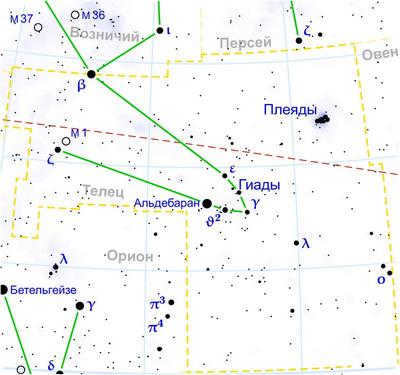
The Hyades cluster, located in the constellation Taurus, possesses a unique set of characteristics.
In comparison to the Pleiades cluster, the Hyades cluster is distinguished by its older age and diverse stellar composition. Within the cluster, one can find stars that closely resemble our Sun, as well as red giants, which are indicative of a more advanced stage of stellar evolution.
Furthermore, it is significant to mention that the Hyades cluster is gradually moving away from Earth. As a result, in the distant future, its observation will become increasingly challenging.
The Pleiades cluster
The Pleiades cluster is a group of seven bright stars that were named after the daughters of the legendary king Atlas and his wife Pleione: Alcyone, Taygeta, Merope, Celaeno, Electra, Asterope, and Maia (collectively known as the Pleiades). According to Greek mythology, when the Pleiades were being pursued by Orion, the god Zeus placed them in the sky. However, even in their celestial form, Orion continues to watch over them.
The Pleiades are located to the right of Aldebaran and have a distinctive shape resembling a bucket, which makes them relatively easy to spot in the night sky even without the aid of a telescope.
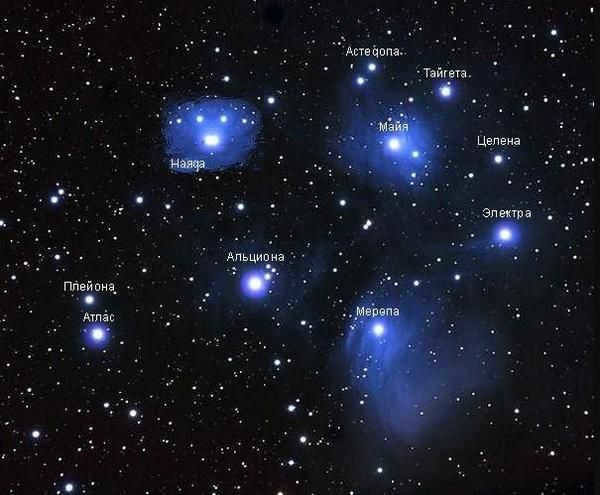
The primary stars of the Pleiades cluster.
All of the primary stars in this cluster are massive white giants with intense luminosity. However, there are also numerous other stars that are not as bright. Among them are hypothetical twins of our Sun, as well as white giants. Interestingly, stars the same size as the Sun within the Pleiades cluster can only be observed through a telescope. However, there are no red giants present here, as red giants are typically associated with older stars, whereas the Pleiades cluster is dominated by youthful stellar bodies.
The Pleiades cluster is relatively young compared to the rest of the galaxy, with an estimated age of around 100 million years. What’s fascinating is that there are nebulae located near the stars Merope and Maia. In the past, scientists believed that these nebulae were leftover gases from which the stars themselves formed. However, the prevailing viewpoint now suggests that these nebulae are unrelated to the Pleiades cluster stars and simply happened to cross their paths.
One of the most interesting and exceptional objects in the constellation of Taurus is the Crab Nebula. It was the initial object mentioned in the Monsieur catalog, and furthermore, it was the catalyst for the development of this very catalog. The Crab Nebula originated from a powerful supernova explosion, which was even observed on Earth in the ancient year 1054 (medieval Arab and Chinese astronomers documented this event). Naturally, this explosion did not occur in 1054, but rather 6500 years earlier; it was only in 1054 that the light from it finally reached the Earth.
The Crab Nebula is the remnants of a supergiant star that expelled its material as a result of the subsequent collapse and explosion. It is an enormous cloud spanning 11 light years, and what’s more, this cloud is still expanding at a speed of 1500 kilometers per second.
A pulsar was found in the center of the Crab Nebula in 1968. This pulsar is a neutron star that has a diameter of approximately 30 km and a mass equivalent to 2.5 times that of the Sun. It rotates at a rate of 30 revolutions per second, and studying it yields numerous valuable findings for astronomers.
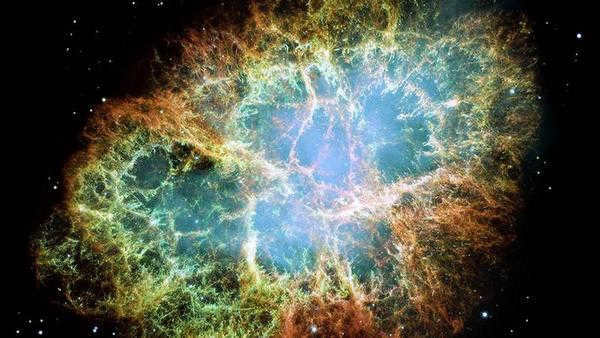
This is the appearance of the Crab Nebula.
Observation of the Crab Nebula is possible exclusively through binoculars or a telescope. It is worth noting that its form has been undergoing continuous changes for several decades due to its rapid expansion rate.
In our article, we focused on the most captivating objects within the Taurus constellation, rather than providing an exhaustive list.
The constellation Taurus offers a plethora of fascinating celestial objects for observation
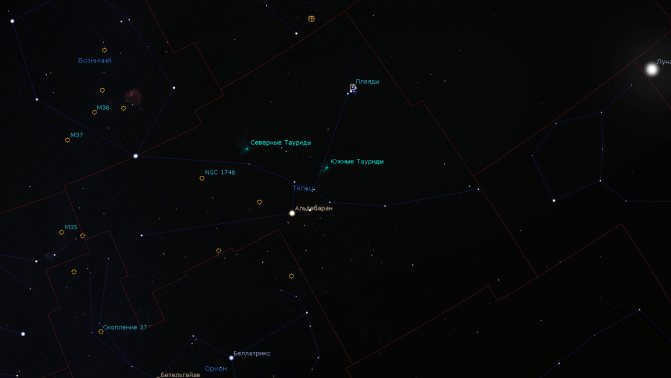
The Hyades: A Dispersed Star Cluster in the Night Sky
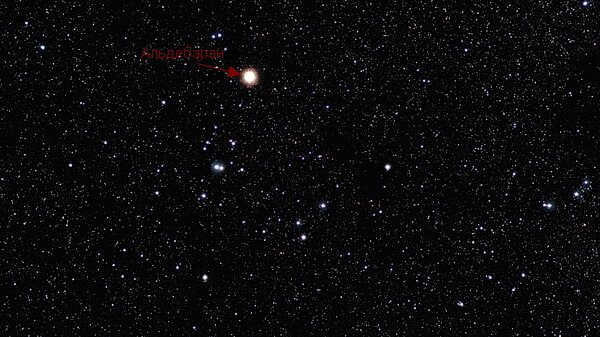
The Hyades is a massive cluster of stars that covers an area of 8° in the celestial sphere and consists of approximately 200 stars located about 150 light-years away from our solar system. The Hyades is recognized as the nearest dispersed star cluster to Earth. Interestingly, the bright star Aldebaran has no physical connection to the Hyades, but it happens to be positioned nearby from our perspective. It is worth noting that the Hyades does not have any other designation in astronomical catalogs, which is why it lacks an ordinal number. In works of science fiction, the Hyades often serve as a backdrop for stories, such as a spaceship traveling through the cluster or the setting for events taking place on one of its planets.
No astronomical instruments will be necessary to observe this cluster; however, in certain cases, one may use binoculars to closely examine specific areas of it.
The Pleiades Cluster (M 45)
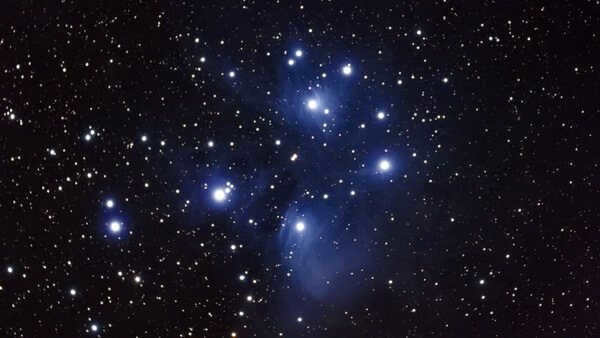
It’s highly unlikely that there’s a person interested in astronomy who hasn’t observed this incredible star cluster. It is easily visible without a telescope, appearing as a small group of seven bright stars. This is why it is commonly referred to as M 45 or the Seven Sisters. There is a wealth of information available online about this dispersed cluster, so I won’t repeat it all here. However, I will mention that the cluster contains approximately 400-500 stars and takes up an area slightly larger than 1.8 degrees in the night sky. It is located approximately 407 light years away from the Sun. As for its age, the cluster is relatively young, with an estimated age of no more than 50 million years. The majority of its stars are hot and blue, falling into a specific spectral class.
The members of the cluster M 45 are encompassed by a reflecting nebula, which is visible with a telescope at lower levels of magnification, utilizing a wide-angle eyepiece and a flawlessly dark sky. Recall the piece in the Expectation and Reality series about dispersed clusters? In that piece, I displayed an authentic photo that objectively reflects what you observe through binoculars, for instance. Locating the Pleiades is quite simple, just refer to the overall map of Taurus above – from Aldebaran, you can easily spot this “bucket”.
Crab Nebula (M 1 or NGC 1952)
The Crab Nebula, also known as M1 or NGC 1952, is a supernova remnant and pulsar wind nebula in the constellation Taurus. It was first observed by Chinese astronomers in 1054, and later recorded by Western astronomers in 1731. The nebula is located about 6,500 light-years away from Earth and has a diameter of about 11 light-years.
The Crab Nebula is the result of a supernova explosion that occurred over a thousand years ago. The explosion was so powerful that it was visible to the naked eye for several weeks. The remnant of the explosion is now expanding at a rate of about 1,500 kilometers per second.
At the center of the Crab Nebula is a pulsar, a highly magnetized rotating neutron star. The pulsar emits beams of radiation that sweep across the Earth like a lighthouse, creating a pulsating effect. The pulsar rotates about 30 times per second, making it one of the fastest-spinning objects in the universe.
The Crab Nebula is one of the most studied objects in astronomy. It has been observed and studied by numerous telescopes and spacecraft, providing valuable insights into the physics of supernovae and pulsars. The nebula’s intricate structure and unique properties continue to fascinate scientists and astronomers.
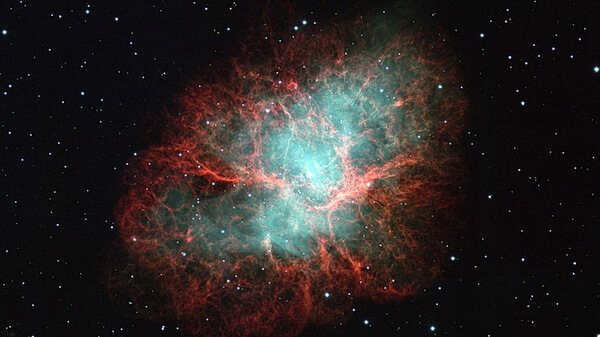
M 1 is a remarkable example of a supernova star that erupted in 1054. This nebula is located approximately 9-10 light years away from the Sun. At the core of the nebula resides a pulsar known as NP 0532, which pulsates every 0.033 seconds. The pulsar emits a luminosity between 14.4 and 17.7m in the visible spectrum. The linear dimensions of M 1 are roughly 6 × 4′, with a brightness of 8.4m. However, don’t expect this object to be easily captured – it holds many mysteries and can be elusive upon first encounter. To locate it, you’ll need a clear sky, away from city lights and the moon’s brightness. Begin by finding the star ζ (zeta) Taurus, then slightly raise the telescope tube.
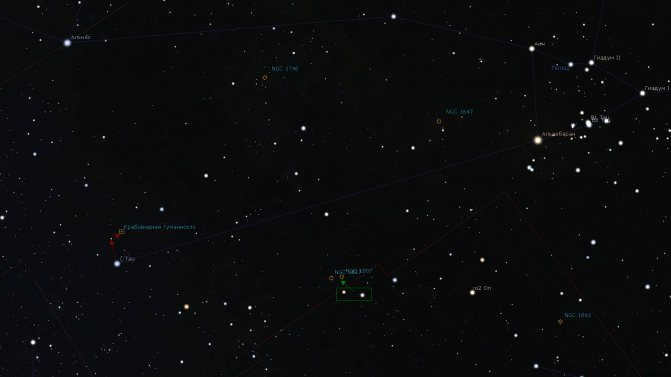
NGC 1807 and NGC 1817: A Fascinating Duo of Dispersed Star Clusters
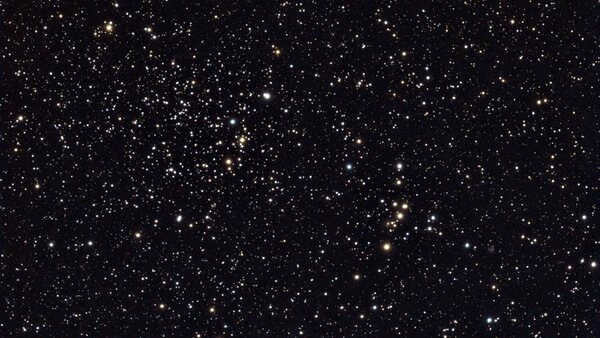
NGC 1807 and NGC 1817 are a pair of stunning and brilliant star clusters that are scattered across the sky. These clusters can be seen with the naked eye on clear nights, and when viewed through binoculars, both can be observed in the same field of view. NGC 1807 covers an area of 17′ and has a brightness of 7m, while NGC 1817 spans 16′ in the sky and has a brightness of 7.7m. These clusters are located near the constellation Orion and can be easily found by referencing the neighboring bright stars (refer to the star map above).
The planetary nebula NGC 1514
is a celestial object that is characterized by its unique and beautiful appearance. This nebula, which is located in the night sky, has captured the attention of astronomers and stargazers alike. Its distinct shape and vibrant colors make it a popular subject for observation and study. NGC 1514 is an example of a planetary nebula, which is formed when a star reaches the end of its life and expels its outer layers into space. The resulting nebula is composed of gas and dust, which create the stunning visual effects seen in NGC 1514. Scientists continue to study this fascinating celestial object to better understand the life cycle of stars and the processes that occur in the vastness of space.
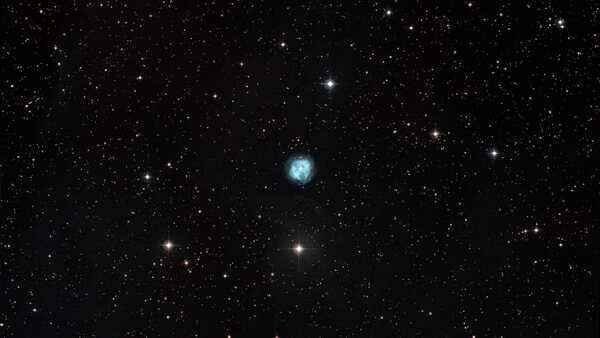
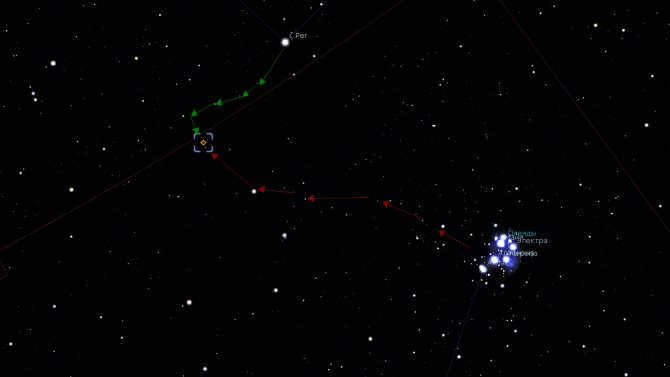
NGC 1647: A Dispersed Group of Stars in Outer Space
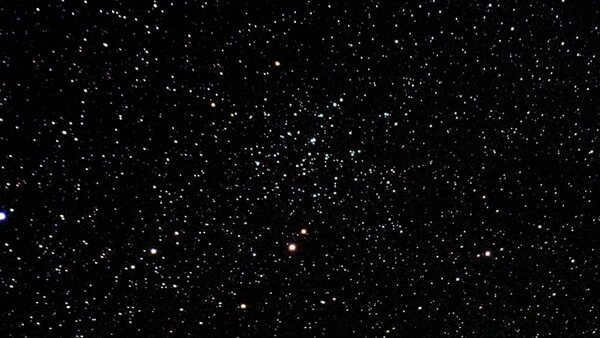
The cluster NGC 1647, which is scattered and has a low saturation, contains just over 150 stars. It has a combined brightness of 6.4m and covers an angular area of 45′. Due to its close proximity to surrounding stars, it is unlikely to be visible to the naked eye. However, it can be easily located using binoculars, making it an ideal target for beginners. To locate NGC 1647, simply move to the left side from the Hyades (or the star Aldebaran). The direction is indicated by a red arrow on the map below:
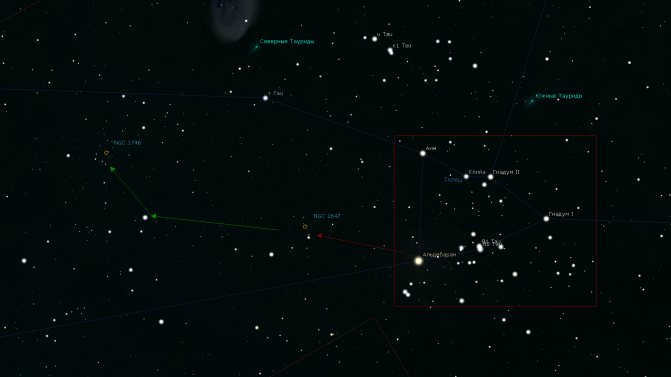
Dispersed stellar aggregation NGC 1746
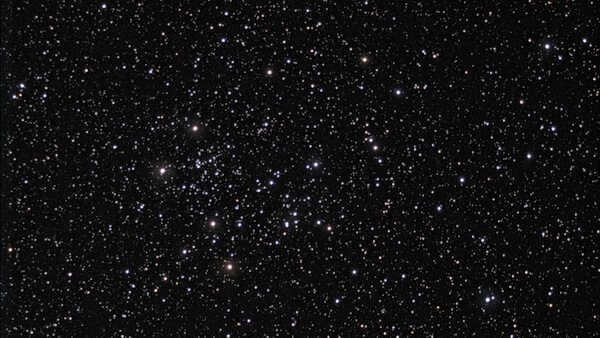
When it comes to brightness and size, NGC 1746 is just as impressive as the previous cluster. It boasts around 200 stars, with a few standout ones along the perimeter that form a striking visual of the cluster. If we continue in a straight line from the Hyades, passing through NGC 1647, we will eventually encounter NGC 1746 (indicated by the green arrows on the map above).
Recommended literature and helpful links
- Allen, Richard Hinckley. Star names: their lore and significance. – corrected. – Dover Publications, 1963. – P. 383. – ISBN 978-0-486-21079-7.
- Chartrand, Mark R. Skyguide: A Field Guide for Amateur Astronomers. – Golden Books Publishing Company, 1983. – ISBN 0-307-13667-1.
- Levy, David H. Deep Sky Objects. – Prometheus Books, 2005. – ISBN 978-1-59102-361-6.
- O’Meara, Stephen James. Deep-sky companions: the secret deep. – Cambridge University Press, 2011. – ISBN 978-0-521-19876-9.
- Ridpath, Ian; Tirion, Wil. Monthly sky guide. – 6th. – Cambridge University Press, 2003. – ISBN 978-0-521-53306-5.
Video of the Taurus Constellation

Author: Pavel Chaika, editor-in-chief of Poznavaika magazine
When composing this article, I made an effort to ensure its content is engaging, informative, and of high quality. I would greatly appreciate any feedback or constructive criticism you may have, which can be shared by leaving a comment under this article. Additionally, if you have any questions, suggestions, or wishes, feel free to reach out to me via email at [email protected] or through Facebook. Thank you, and best regards, the author.
This article is also available in English – Taurus Constellation: Location, Myth, Picture.
In the original article about the Taurus Constellation, certain illustrations were displayed using JavaScript, which may cause them to not appear on all devices. However, on this page, all images are presented for your viewing pleasure.
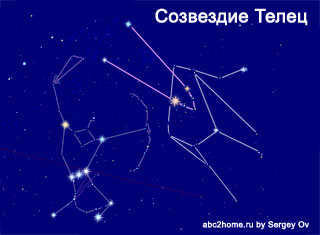

Diagram of Taurus. This is a representation of the constellation Taurus, also known as the Bull, symbolized as ♉.
The constellation Taurus (♉ Taurus) is ranked sixth among the zodiacal group constellations in terms of angular area [1]. It holds the seventeenth place in the area ranking of the entire celestial sphere (firmament), and is the ninth largest constellation in the Northern Hemisphere, covering 797 sq. deg. It follows the constellation of Swan.
The celestial equator passes very close to the southern boundary of Taurus. Due to its predominant position in the Northern Hemisphere, Taurus is considered a northern equatorial constellation [2].
Taurus is bordered by seven constellations, including Gemini, Ascendant, Perseus, Aries, Whale, Eridanus, and Orion.
Currently, the Sun is transiting through the constellation of Taurus, from May 14 to June 21, covering a period of 38 days. This makes it the second longest occupied segment of the ecliptic, following the constellation of Virgo.
In Figure 2, you can see the boundaries of the constellation and the majority of the stars that are visible. This particular image depicts the constellation Taurus at the exact moment of culmination, which is the most common view of constellations in the field of astronomy.
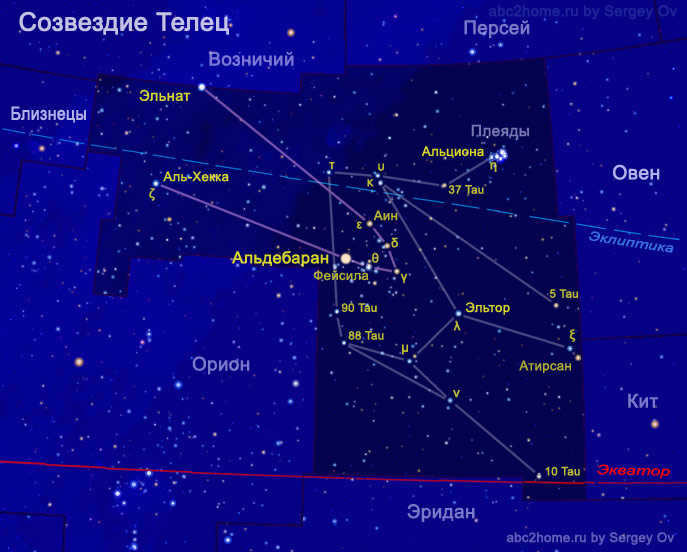
Fig. 2Tau. The arrangement known as Taurus. Historically recognized and sanctioned by the International Astronomical Union (IAU), the names of the most prominent stars.
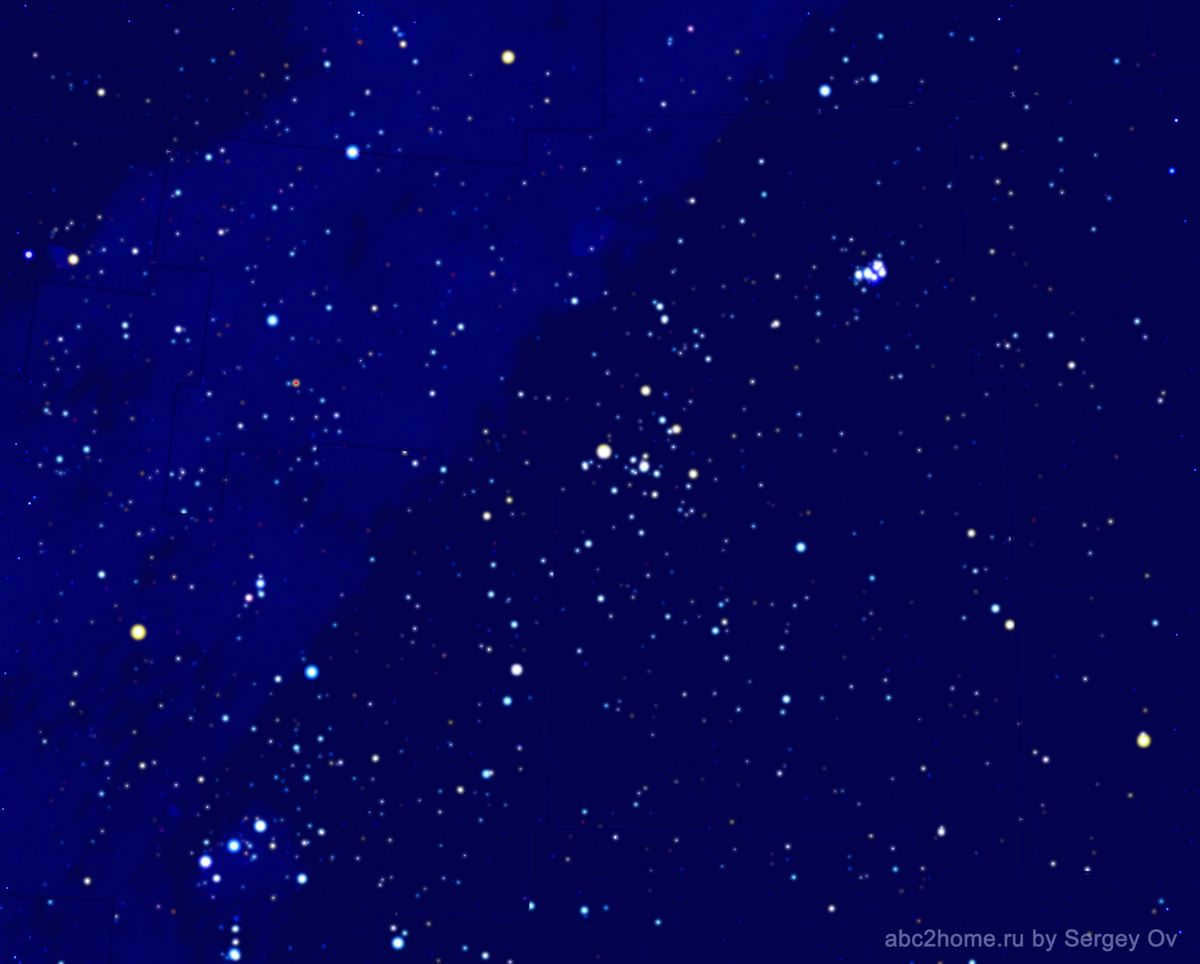
The Taurus constellation is composed of various stars. It is represented by the image shown in Figure 2.1.Tau. Sergey Ov
Fig. 2.1. The Taurus constellation – stars of Taurus. Take advantage of this sketch to practice sketching the outlines of the Taurus constellation
To view the stars of the constellation in full screen, click on the image. The main astronomical attractions of Taurus that can be seen with the naked eye are the Pleiades and Hyades star clusters. 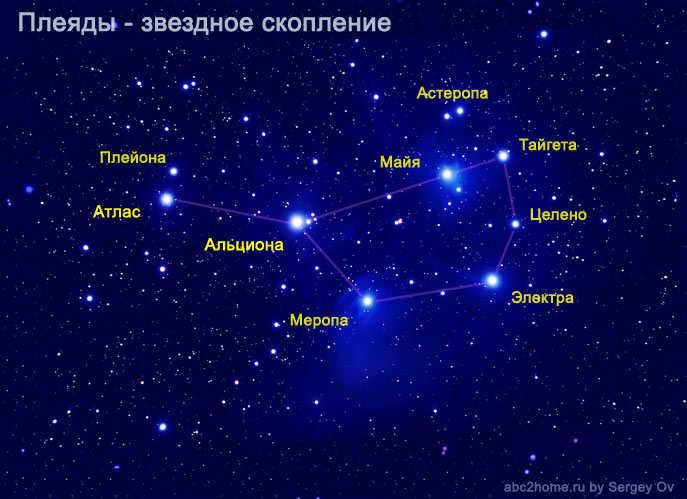
Fig. 3Tau. The Pleiades star cluster 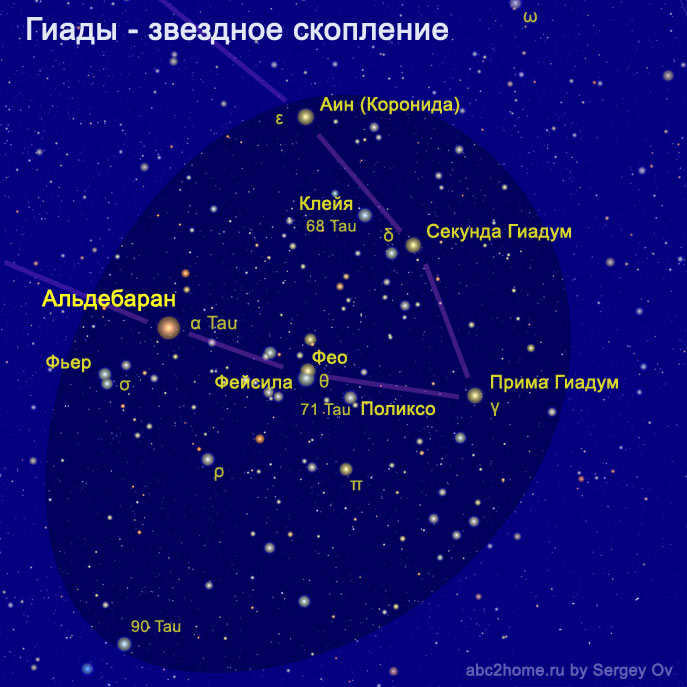
Fig. 4.Tau. The Hyades star cluster The ancient Greeks, who have passed down to us the modern outlines of the constellations, observed the stars of the zodiac belt in a different way from how we see them in our average latitudes. At the latitude of Athens and even more so Alexandria, they pass near the zenith, and the ecliptic line is almost perpendicular to the horizon.
Therefore, for Taurus, I have attempted to find my own outline sketch based on the vertical position of the ecliptic line on the starry sky map.
In the oldest surviving catalog of Ptolemy (“Almagest”), Taurus is described in a very different way, but most likely, this is how it was seen by the ancient astronomers of the Middle Ages, who gave it its name. 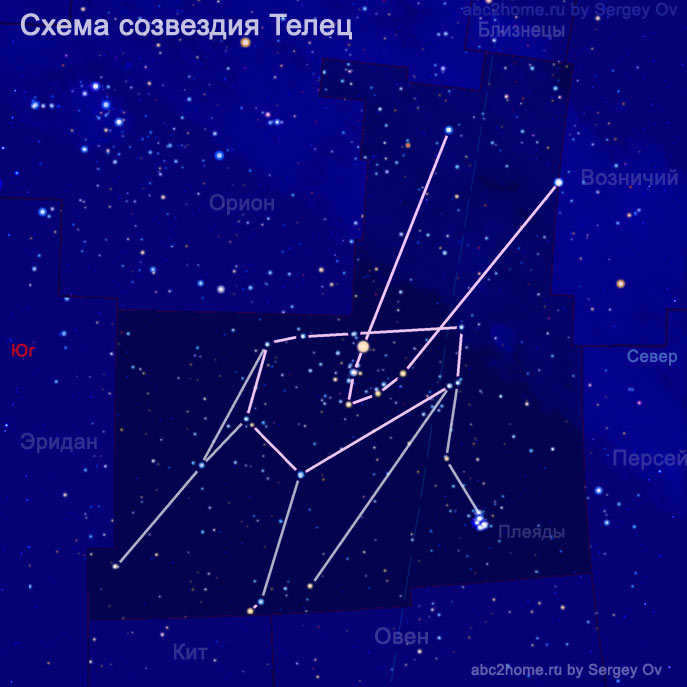
Fig. 5.Tau. The Taurus constellation (♉ Taurus – Latin), diagram, as it can be seen before setting in the southwest. Probably one of the oldest versions of the outline sketch of Taurus. The asterism “sign of Taurus” is also highlighted
Author’s version of the star chart (outline image) of the Taurus bull. 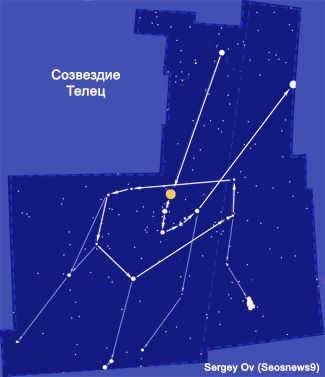 Fig. 5.1.Tau. The Taurus constellation, 2012
Fig. 5.1.Tau. The Taurus constellation, 2012
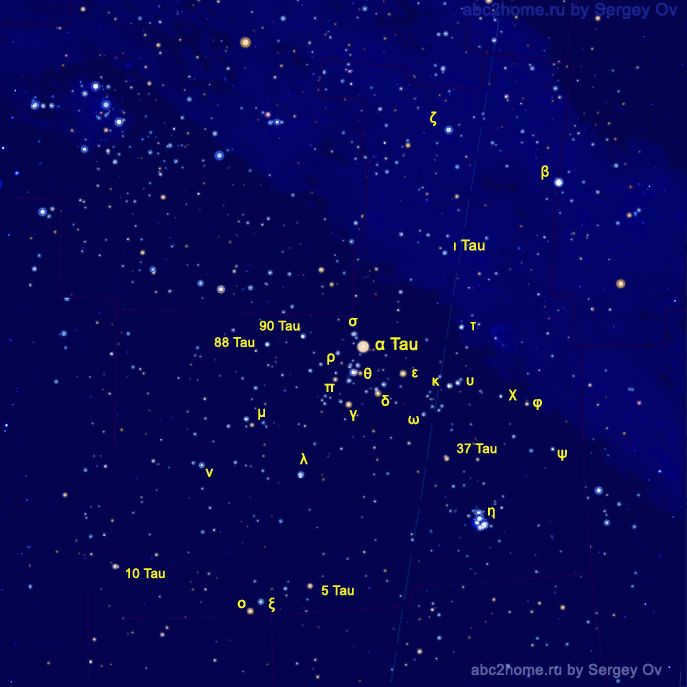
Taurus constellation diagram created by Sergey Ov using stars
Fig. 5.2.Tau. Illustrations representing the Taurus constellation: Bayer’s designation of Taurus stars.
When a constellation has a significant number of relatively bright stars, it is possible to create various graphic drawings by connecting these stars.
In figure 6.Tau, there are four alternate schematic images of Taurus stars, visible at its culmination: 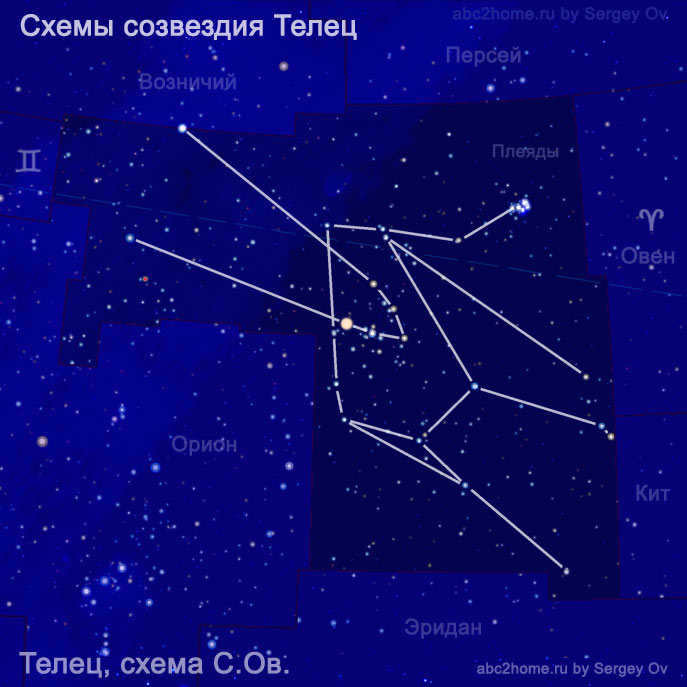
Fig. 6.Tau. Different variations of schematic images of Taurus stars – seen at the culmination position of the constellation: 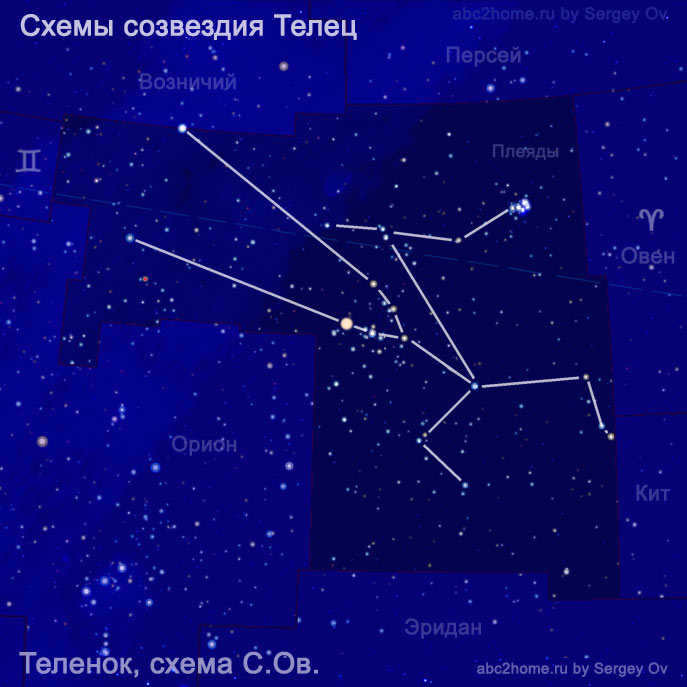
Fig. 6.2 .Tau. Schematic diagrams of the Taurus constellation: Calf tumbling; 
Fig. 6.1.Tau. Schematics of the Taurus constellation: Drawing of Taurus, diagram by S. Ove; 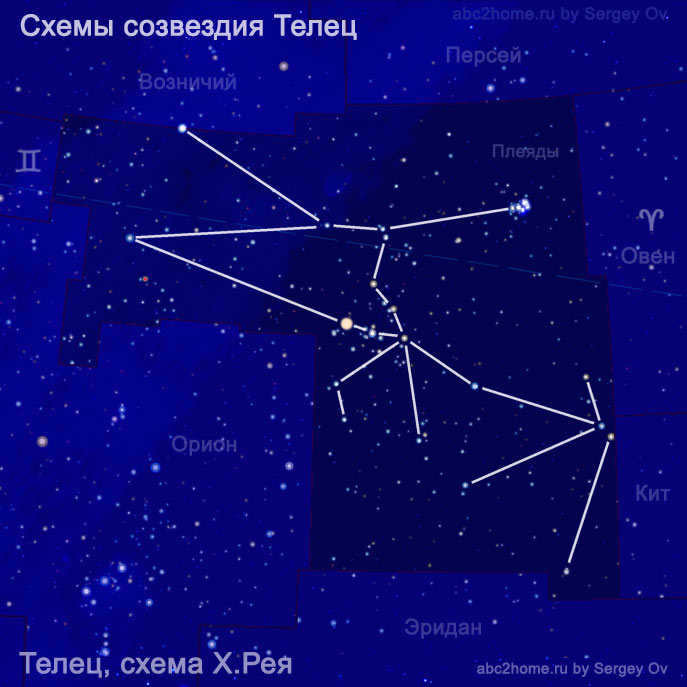
Fig. 6.3.Tau. Schematics of the Taurus constellation: Drawing of Taurus, scheme by H. Ray; 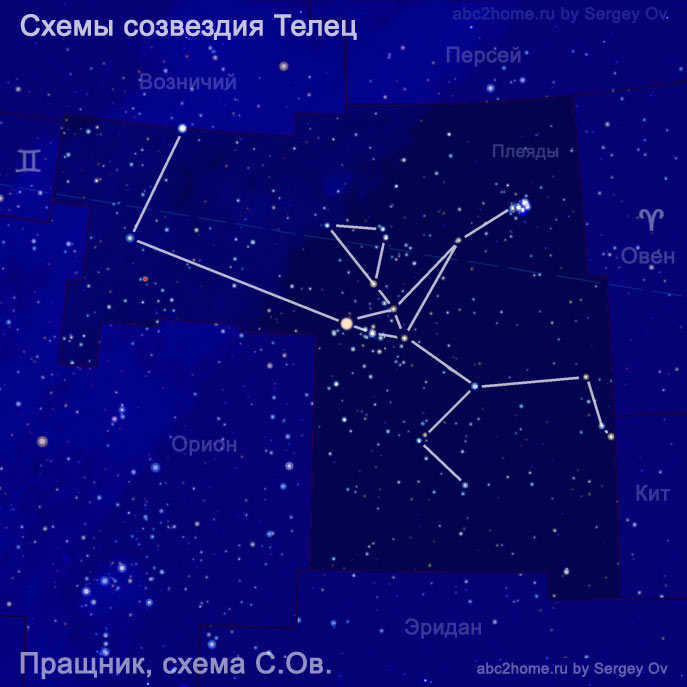
Fig. 6.4.Tau. Schemes of the Taurus constellation: Praschnik with fustibal.
Another fruitful direction for drawing schematic illustrations is the West-East direction. In figure 7.Tau, a set of schematic images of stars that can be observed when looking at the constellation from west to east (or above the western horizon before the constellation sets) is shown: 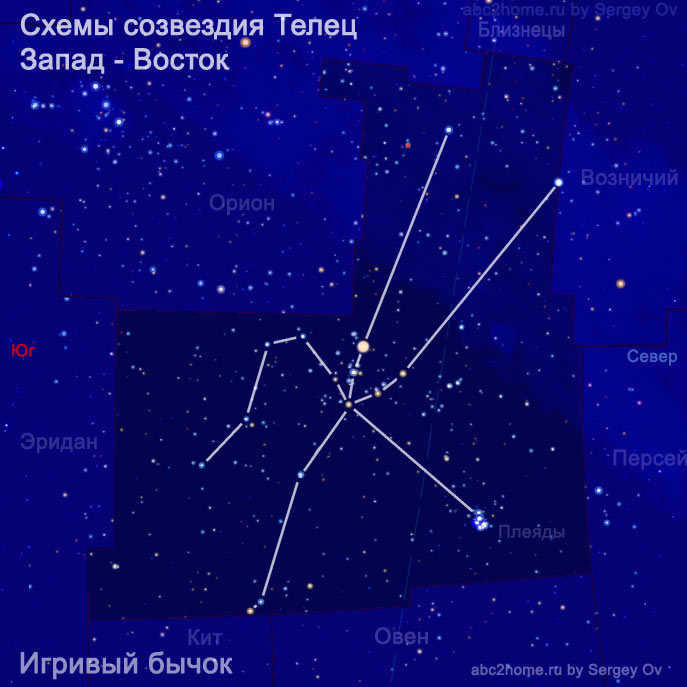
Figure 7.1.Tau. Schematic drawings created when observing the Taurus constellation from west to east: The playful goby 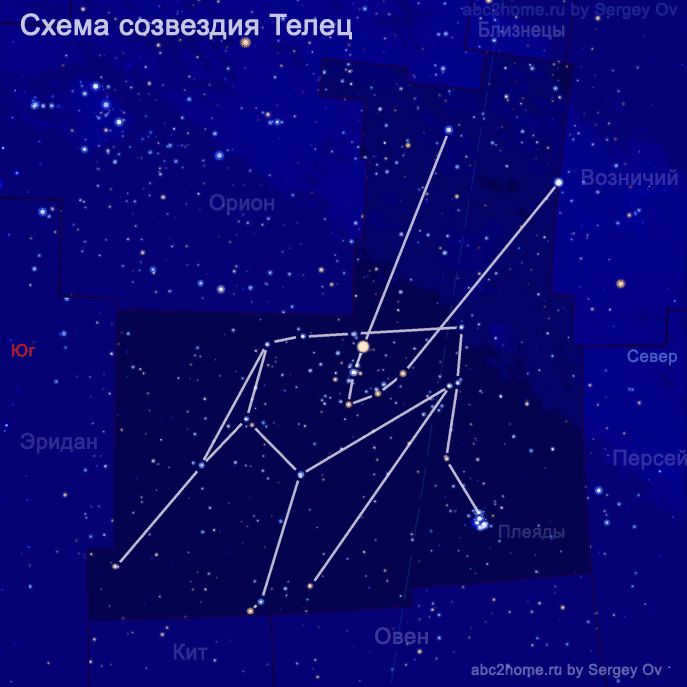
Fig. 7.2.Tau. Schematic drawings: Taurus, scheme by S. Ov 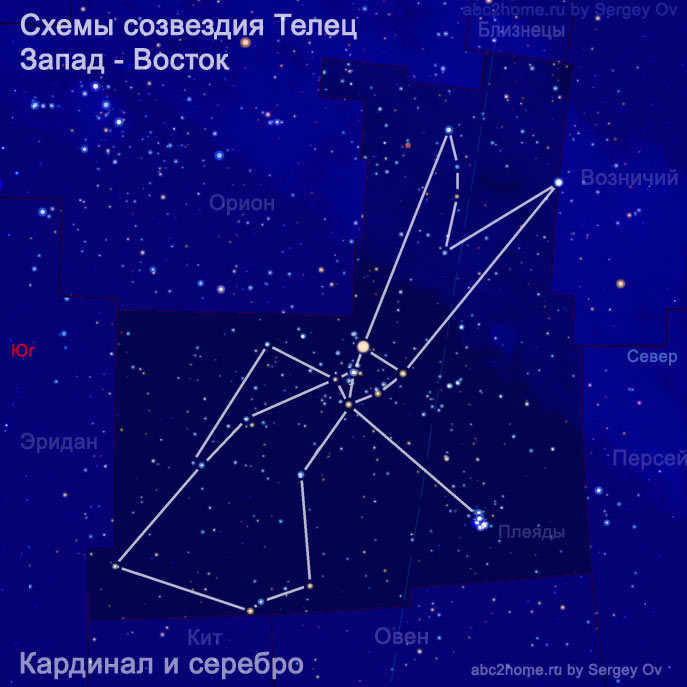
Fig. 7.3.Tau. Schematic drawing: Cardinal and silver 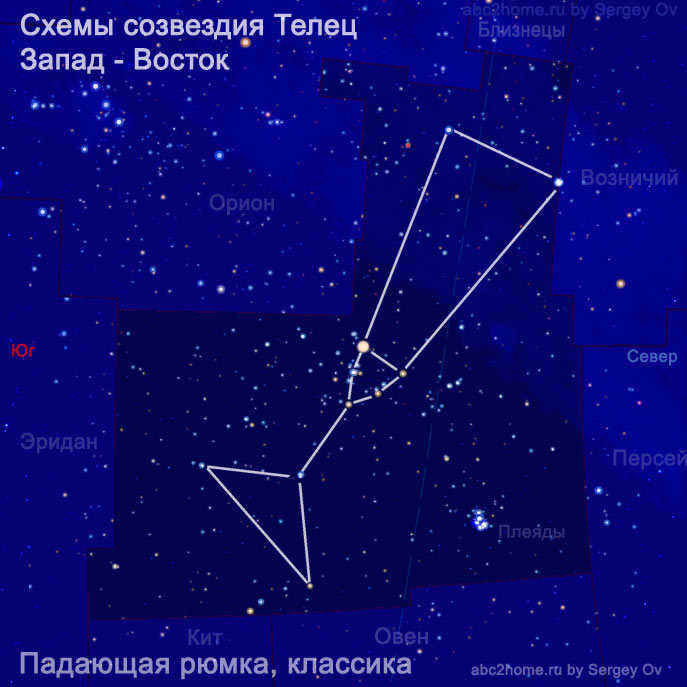
Fig. 7.4.Tau. Schematic Drawing: The Falling Cup
Looking at the Taurus constellation from the other two directions of the world will also yield results.
If we observe the Taurus constellation from north to south, the largest drawing that occupies almost the entire space dedicated to the constellation is the schematic image of Mickey Mouse (Fig. 8.Tau ):
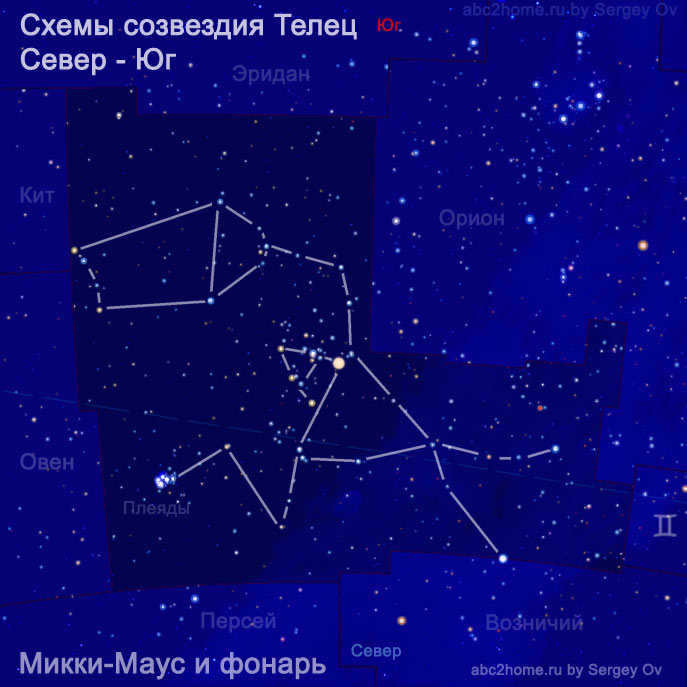
The Taurus constellation is depicted in a contour drawing resembling Mickey Mouse. This diagram, created by Sergey Ov, showcases the unique shape of this constellation.
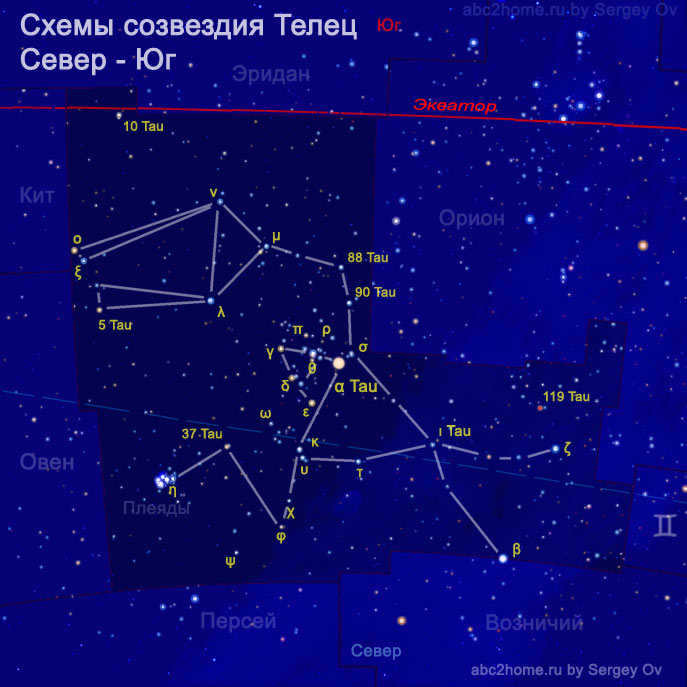
Mickey Mouse and stars
Figure 8. Tau. The stars of the Taurus constellation are depicted in a schematic drawing. Mickey Mouse is holding a lantern. When observing the Taurus constellation from an east-west direction, a contemporary viewer can envision a large paraglider filling the entire designated area (Figure 9. Tau):
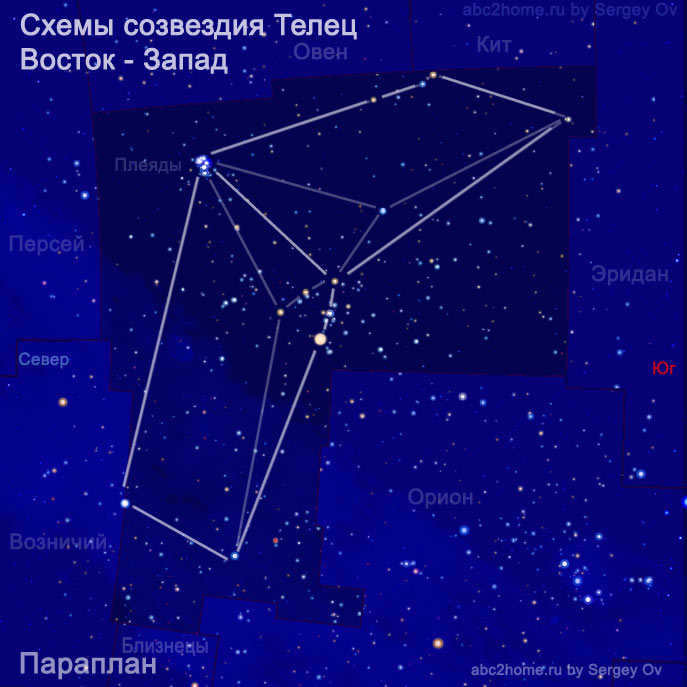
The Taurus constellation is depicted as a paraglider in this schematic drawing by Sergey Ov.
Fig. 9.Tau. This image shows the stars connected in the Taurus constellation, resembling a paraglider (Spaceplane). If you observe the rising Taurus constellation, you can also envision a whimsical starship by utilizing the brightest stars.
For young stargazers:
Gradually, we are building up a collection of portraits featuring both big and small felines in the form of stars: the Lion, located in the Leo constellation; Kitten Woof in Perseus; Star Cat (Fig.6.Cyg) and Star Cat (Fig.7.Cyg) in Swan.
Some time ago, this expanding gallery gave rise to an intriguing thought:
– What if there are Star Cats concealed within every constellation?
Now, we will put this idea to the test as we further explore constellations and attempt to substantiate, as it were, the theorem “Regarding the behaviors of star cats and regular cats.” Theorem:
Within any sufficiently large constellation, there could exist a lurking Star Cat. And those familiar with Lewis Carroll’s “Alice in Wonderland” will also grasp the following axiom:
In any given constellation, one can find traces of the Cheshire Cat’s grin. In the Taurus constellation, both the theorem and the axiom were confirmed (Fig. 10.Tau). On a clear night, near the star Aldebaran, one can spot a playful kitten attempting to paw at this star.
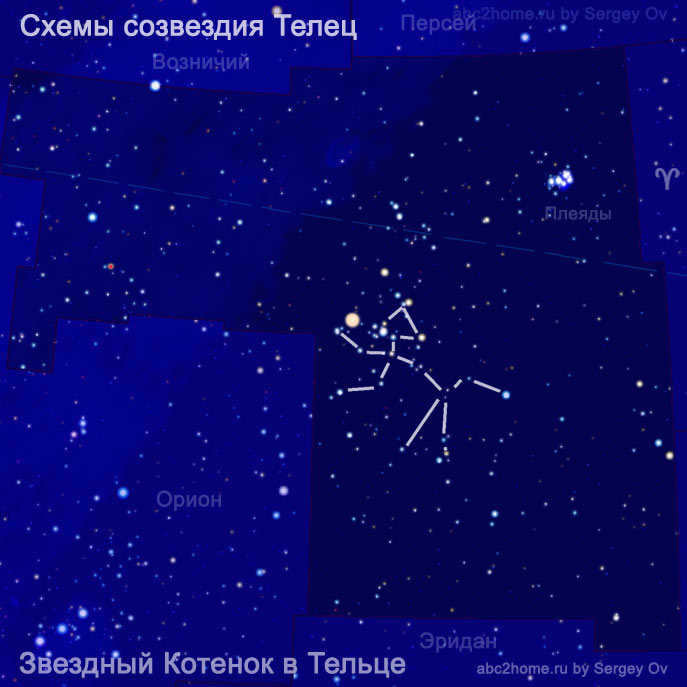
Diagram of the Taurus constellation called “Star Cat” created by Sergey Ov. It is a contour drawing of the constellation with the figure labeled as Figure 10.Tau. The diagram shows the stars of the Taurus constellation, including the star known as Kot, which has the ability to change color and turn red. This diagram was created by Sergey Ov.
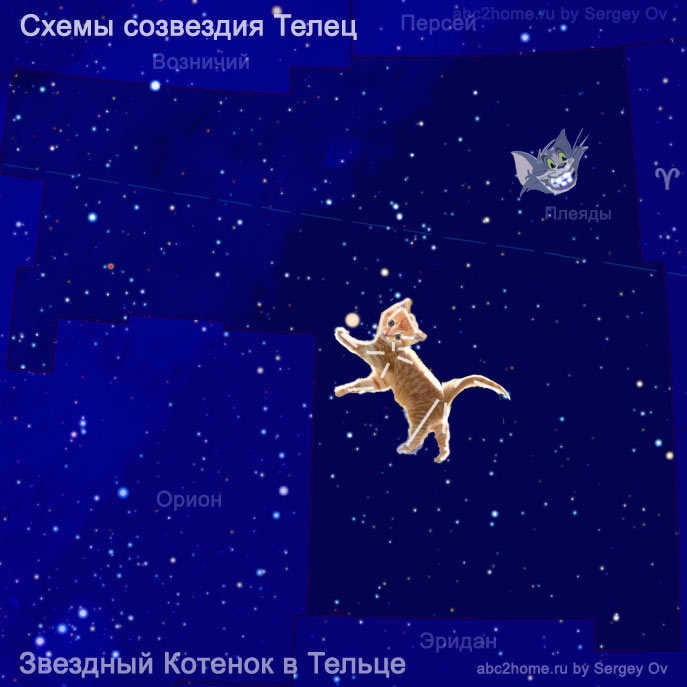
Red Star Cat (Koot)
Sergey Ov
Fig. 10.2.Tau. The Red Star Kitten and the grin of the Cheshire Cat. This illustration also clearly portrays the fact that the Pleiades are simply the radiant smile of the now vanished Cheshire Cat:
Alice, speaking to the Cat
– It’s quite embarrassing how you appear and disappear so suddenly! It’s dizzying.
– Really?" said the cat, and this time he vanished very slowly, starting from the tip of his tail and ending with a smile that lingered even after the cat had vanished.
‘I’ve often seen cats that don’t smile,’ thought Alice. – But a smile without a cat! That’s the most incredible thing I’ve ever witnessed here.”. Lewis Carroll. Alice in Wonderland
Chapter Six. The Pig and the Pepper
Asterisms in the Constellation of Taurus
The Pleiades and Hyades star clusters are the oldest known asterisms in the constellation of Taurus. Recently, astronomers have discovered a new arrangement of stars that resembles a fishing hook, and this asterism has been named (Figure 11 Tau):
There are also other smaller asterisms in Taurus, as shown in the image below:

Fig. 11.Taurus. The constellation Taurus is home to several small asterisms, including the Pleiades, Hyades, Star Cluster asterism, and Fishing Hook asterism. One of the most unique asterisms of Taurus cannot be seen without binoculars – it appears as a pseudo star cluster, but is actually a group of independent stars.
The Horns of Taurus (Fig. 12.2.Tau) is the largest ancient asterism in the constellation and is often referred to as the Big V asterism in English-speaking countries. Another ancient asterism in Taurus is the Taurus Sign asterism (Fig. 12.1.Tau).

Fig. 12.1.Tau. Asterisms of the constellation Taurus: Taurus Sign Asterism.
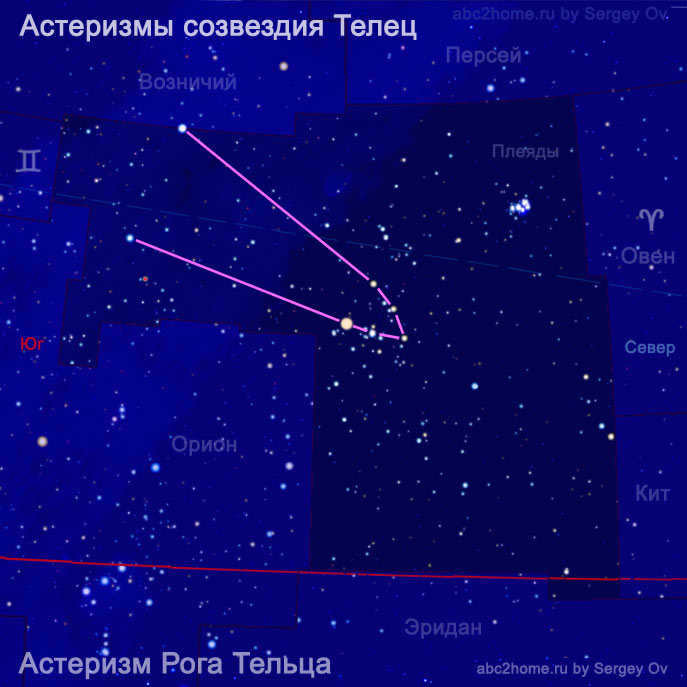
Figure 12.2.Tau. Constellation Taurus contains various asterisms, including the Horn of Taurus.
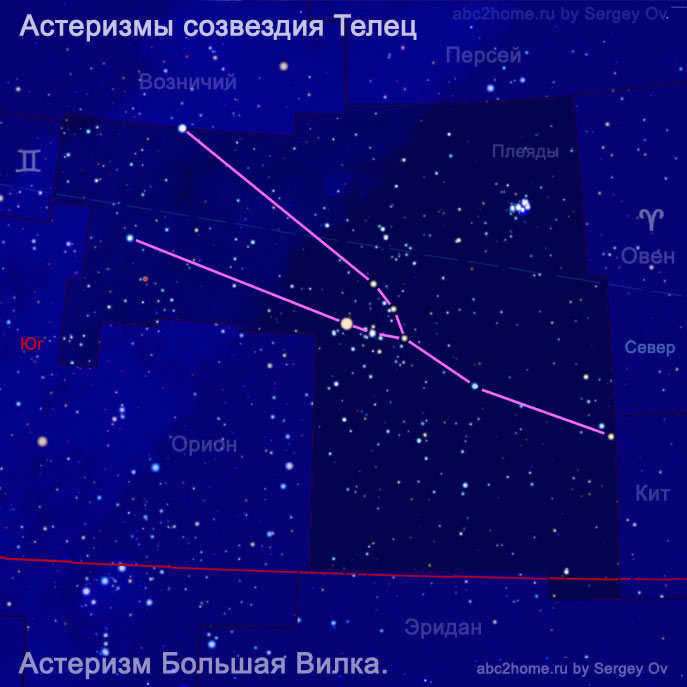
Figure 12.3.Tau. The constellation Taurus showcases various asterisms, including the Big Fork asterism (Culinary)
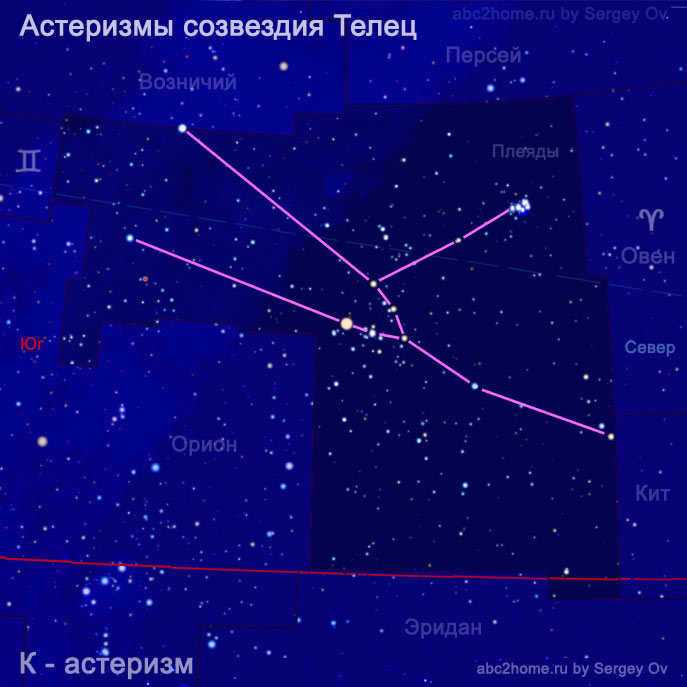
Figure 12.4. Tau. Asterisms in the Taurus constellation: K – asterism
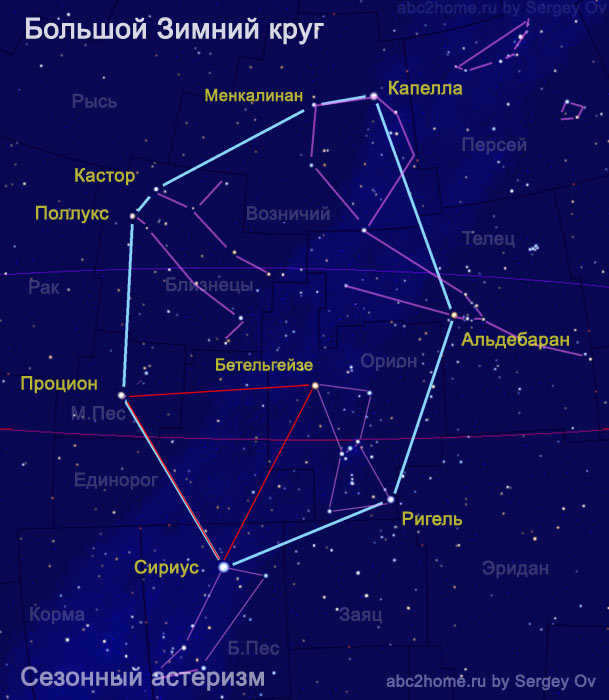
Asterisms can be created by arranging stars not only within a constellation, but also by selecting the brightest stars from multiple constellations.
One example is the star Alpha Taurus – Aldebaran, which is part of the Great Winter Circle or Winter Hexagon, a super-asterism that forms during the winter season. The Great Winter Circle is the largest asterism in the night sky and spans across 9 constellations (Fig. 13.Tau): Fig. 13.Tau. The Great Winter Circle asterism.
Finding the Taurus constellation: A guide
The origin and legend of the Taurus constellation.
A terracotta tablet depicts the celestial symbols of the lunar deity Nanna-Sina, with a primitive immediacy, repeating the star pattern in the designated area of the sky for this deity.
The fact that the author recognized that he was accurately representing the divine attributes leaves no room for doubt regarding the image of the pedestal for the lunar sickle: 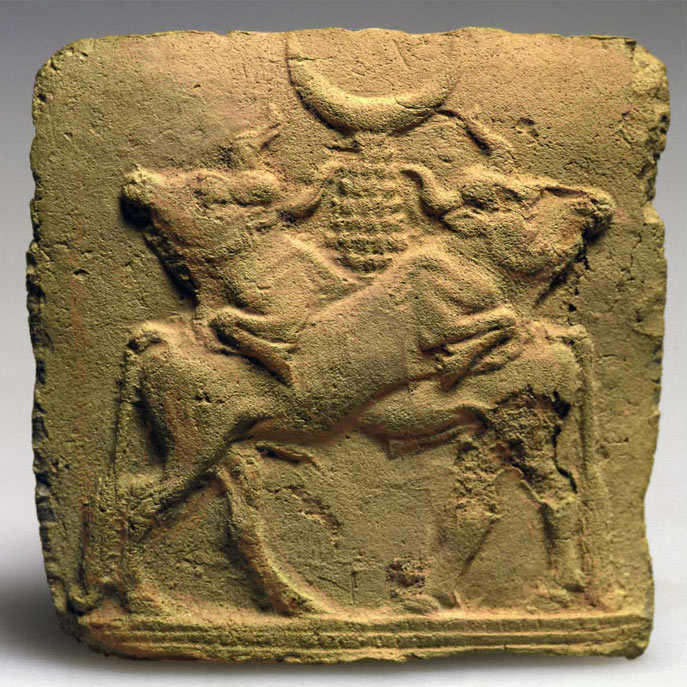 Fig. 18.Tau. Two Bulls and the Moon’s Sickle, Akkad, relief, terracotta, Israel Museum Images similar to the relief. Fig. 18.Tau. are amulet amulets, and the dating of such discoveries dates back to the Akkadian Age (24-23 century BC) and extends to the New Babylonian Kingdom period (9th century BC).
Fig. 18.Tau. Two Bulls and the Moon’s Sickle, Akkad, relief, terracotta, Israel Museum Images similar to the relief. Fig. 18.Tau. are amulet amulets, and the dating of such discoveries dates back to the Akkadian Age (24-23 century BC) and extends to the New Babylonian Kingdom period (9th century BC).
It should be noted that the ancients did not spare the expanse of the heavens for their gods: the star pattern corresponding to the terracotta image of bulls and sickle encompasses 6 modern constellations – Taurus, Perseus, Aries, Cetus, Eridanus, and Orion: 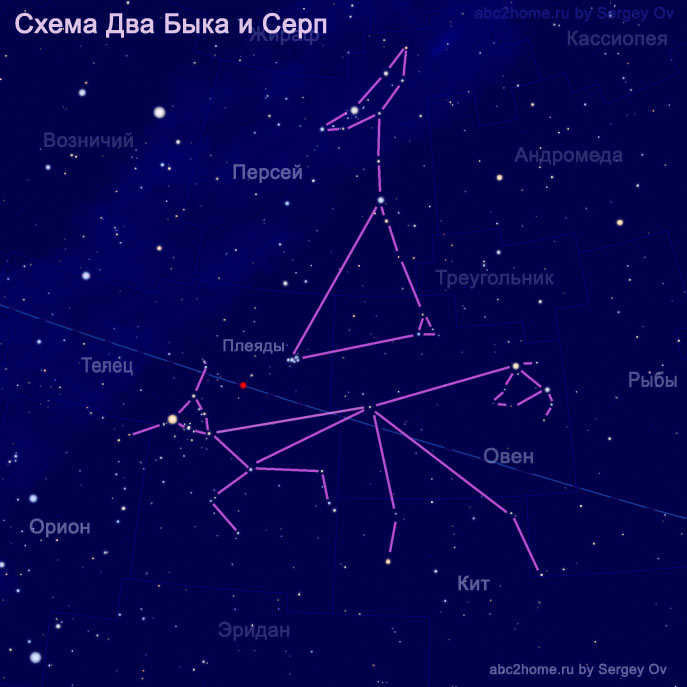 Figure 19.Tau. Diagram of the lines connecting the stars “Two Bulls and the Moon’s Sickle,” the red color on the ecliptic line indicates the position of the vernal equinox point. Figure 19.Tau is a simplified version of the schematic representation of the stars from figure 18.Tau (to simplify perception, all eight legs of the animals and the body of the right Bull, which is now Aries, are not drawn).. The star pattern of the Moon’s Sickle is now known as the asterism Segment of Perseus (Perseus Sickle).
Figure 19.Tau. Diagram of the lines connecting the stars “Two Bulls and the Moon’s Sickle,” the red color on the ecliptic line indicates the position of the vernal equinox point. Figure 19.Tau is a simplified version of the schematic representation of the stars from figure 18.Tau (to simplify perception, all eight legs of the animals and the body of the right Bull, which is now Aries, are not drawn).. The star pattern of the Moon’s Sickle is now known as the asterism Segment of Perseus (Perseus Sickle).
Notice how the vernal equinox point was positioned in the 23rd century, it appears that the Bulls are overshadowing (guarding) the passage to it from unwanted celestial visitors.
Thanks to the epic “On Gilgamesh,” the second image of the star Bull – the winged Bull of Heaven – appeared in Mesopotamia:
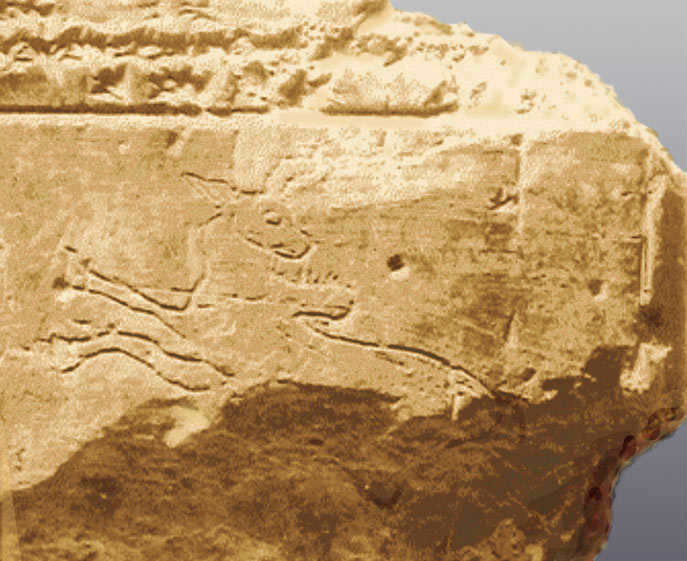
Taurus is known as the Bull of Heaven. This drawing shows the contour of the bull. The diagram was created by Sergey Ov. It is labeled as Fig. 20.1 Tau. The bull is depicted on a clay tablet from Babylon, dating back to the 4th or 3rd century B.C. during the Seleucid era. The tablet is part of the VAT 7851 collection, which is housed in the Staatliche Museen zu Berlin. The drawing also includes the constellations Taurus, Pleiades, and the Sickle of Perseus. Sergey Ov is the artist behind this illustration.
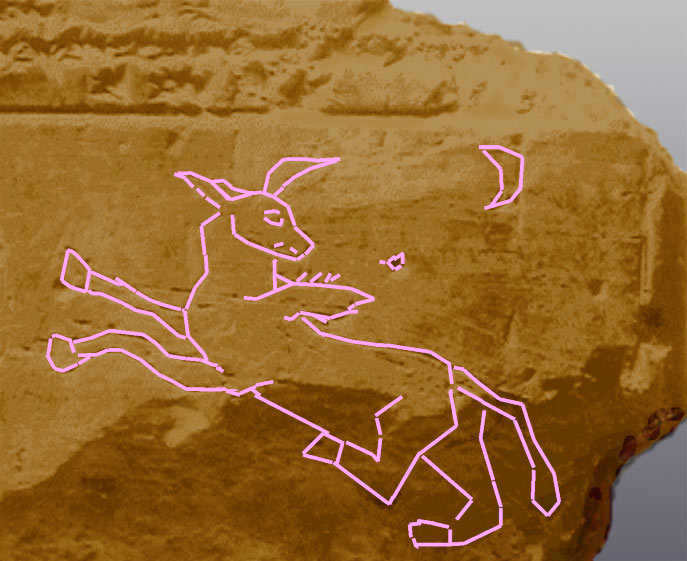
Mickey Mouse and the celestial bodies
Sergey Ov
Fig. 20.2 Tau. A sketch of the Winged Bull’s image. The image of the guardian bulls and the younger gods assisting them had already been separated from the celestial realm and developed independently by the middle of the 2nd millennium B.C. This led to the emergence of winged bulls and winged lions with human faces (Shedu and Lamassu) in various states of the Ancient Near East. These creatures guarded fortress gates in cities and front entrances to palaces: 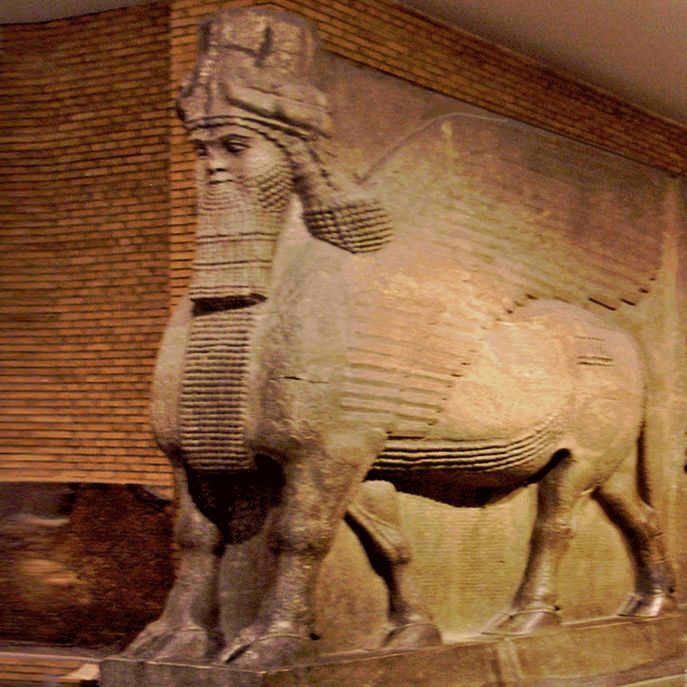 Fig. 21.Tau. Shedu (Lamassu) – Winged Bull, seventh century BC (Reliefs Lamassu from the Palace of Sargon II, The British Museum)
Fig. 21.Tau. Shedu (Lamassu) – Winged Bull, seventh century BC (Reliefs Lamassu from the Palace of Sargon II, The British Museum)
The Persian astronomer al-Sufi. (Abu-l-Hussein Abdurrahman ibn Umar al-Sufi) presented a prototype of Taurus in the 10th century A.D. in his “Book of Fixed Stars,” which was not significantly different from the Ptolemaic description (Fig.22.Tau.):  Fig. 22.Tau. The constellation Taurus in Al-Sufi’s “Book of Fixed Stars” (Al-Sufi. (Al Sufi. Book of the constellations, or fixed stars. – Library of Congress. World Digital Library – informationally not the best, but the most beautiful list of the XV century, commissioned by Ulugbek)
Fig. 22.Tau. The constellation Taurus in Al-Sufi’s “Book of Fixed Stars” (Al-Sufi. (Al Sufi. Book of the constellations, or fixed stars. – Library of Congress. World Digital Library – informationally not the best, but the most beautiful list of the XV century, commissioned by Ulugbek)
The star chart of the constellation is illustrated with a collage based on a painting from Jan Hevelius’ atlas, by mirroring it to give a view “from inside the celestial sphere”: 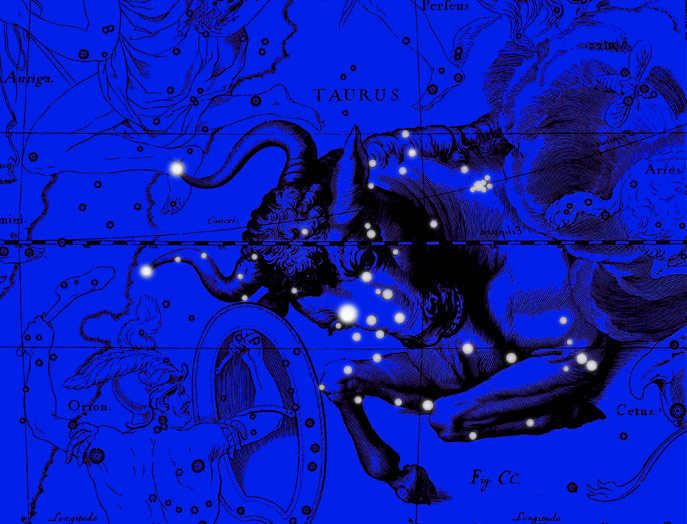 Fig. 23.Tau. Collage of the constellation Taurus based on a picture in Jan Hevelius’ atlas (only those stars are highlighted, which were entered by Hevelius himself in the atlas.) Sergey Ov ( Seosnews9 )
Fig. 23.Tau. Collage of the constellation Taurus based on a picture in Jan Hevelius’ atlas (only those stars are highlighted, which were entered by Hevelius himself in the atlas.) Sergey Ov ( Seosnews9 )
Illustrations for the article: The constellation Taurus, Taurus, the sixth constellation of the zodiacal group
1. The constellations that give their names to the zodiac signs are known as the zodiacal group. The zodiac signs are named after these constellations. Apart from Libra, which was actually created based on the zodiac sign, mainly using stars from the Scorpio constellation.
2. An asterism refers to a collection of stars that form a distinct pattern and have their own unique name. An asterism can either be a part of a constellation, such as the Throne, or it can connect multiple constellations together, like the Summer Triangle.
NAVIGATION AND ADVERTISING
In the article “Summer Starry Sky,” you can explore all the constellations visible from Russia during the summer. Instead of focusing on a specific constellation, the article highlights an asterism known as the “Summer Triangle.” By using this star pattern as a reference, readers can easily locate the other constellations mentioned. (To learn more about asterisms, click here.) So, what other asterisms can we observe in the summer sky?
The key distinction between a constellation and an asterism is as follows: a constellation represents a specific region of the sky with defined boundaries, while an asterism refers to a memorable star pattern that may or may not be entirely contained within a constellation. Here’s an example:
The summer triangle
is a prominent astronomical asterism formed by three bright stars: Deneb, Vega, and Altair. It is named for its appearance in the northern hemisphere’s summer sky, but can be seen from latitudes between 35° and 90°. The summer triangle is not an official constellation, but rather a pattern of stars that are part of different constellations. It is one of the most recognizable star patterns in the night sky and has been studied and admired by astronomers for centuries.
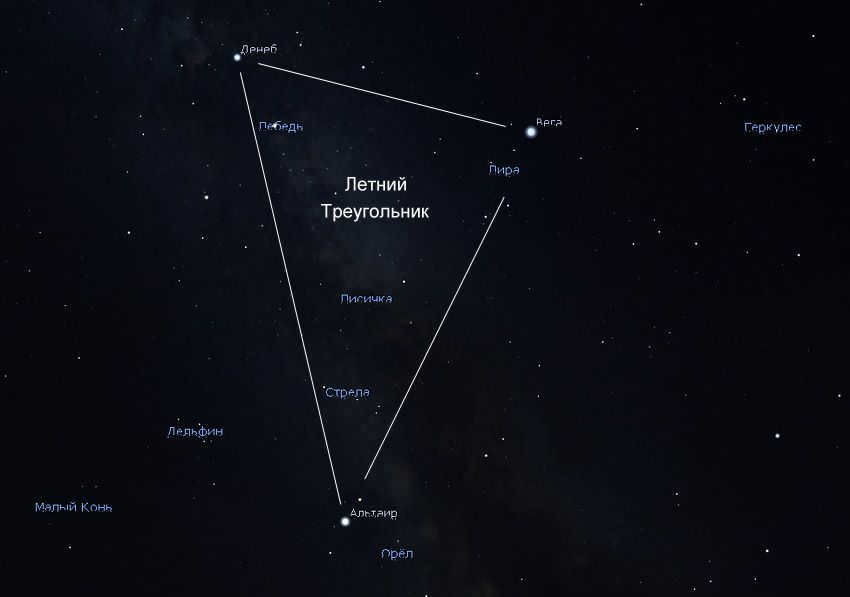
The Summer Triangle is the largest asterism visible in the summer sky. It consists of three prominent stars that belong to different constellations. Vega is located in the constellation Lyra, Deneb is the brightest star in the Swan, and Altair is the main star in the constellation of Eagle. While the Summer Triangle is made up of stars from different constellations, it stands out in the summer sky and serves as a useful point of reference. As a result, it has been recognized as a distinct asterism.
Given that I have previously written about the Summer Triangle on multiple occasions (such as here), there is no need to delve into its details.
Lyra parallelogram
Lyra parallelogram is a geometric shape that resembles a parallelogram and is named after the constellation Lyra.
The Lyra parallelogram, also known as the Lyra-shaped parallelogram, is a four-sided figure with opposite sides that are parallel and equal in length. It is similar to a regular parallelogram, but with a distinctive shape that is reminiscent of the constellation Lyra.
The Lyra parallelogram is often used in geometry and mathematics to demonstrate properties and formulas related to parallelograms. It is a versatile shape that can be easily manipulated and used to illustrate concepts such as angles, sides, and diagonals.
Furthermore, the Lyra parallelogram has aesthetic appeal and is often used in design and art. Its unique shape and symmetry make it visually intriguing and appealing to the eye.
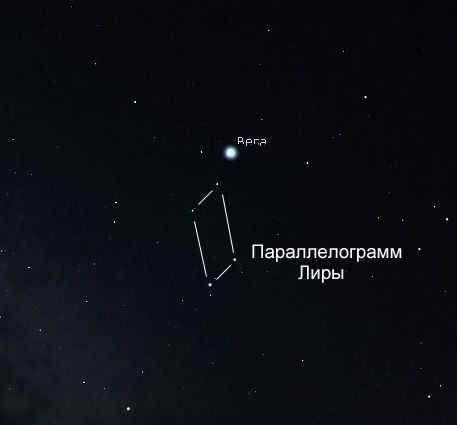
The primary figure of the Lyra constellation consists of four stars, each with a magnitude of either 3rd or 4th, positioned directly beneath Vega. This arrangement forms a small parallelogram shape. Image: Stellarium
Furthermore, we have an example of an asterism that is completely contained within a single constellation. Known as the “Parallelogram,” it is composed of four faint stars situated directly below the prominent star Vega. This particular figure is a part of the Lyra constellation and, in fact, along with Vega, comprises the most noticeable portion of the constellation. During summer evenings, the Lyra Parallelogram can be observed high in the southern sky, nearly at its zenith.
Here’s another example of a constellation contained entirely within another constellation. Allow me to introduce the Northern Cross.
As you may be aware, in the southern hemisphere of the Earth’s sky, there is a small yet highly noticeable constellation known as the Southern Cross. This constellation serves the same purpose as Polaris does in our sky – it acts as a guide to the pole and aids in determining cardinal directions.
The Northern Hemisphere also possesses its own cross-shaped asterism, the Northern Cross. However, it has not been designated as a separate constellation. The Northern Cross is the most prominent feature of the expansive and stunning Swan constellation. It can be conveniently located from the star Deneb within the Summer Triangle, which is also part of the Northern Cross.
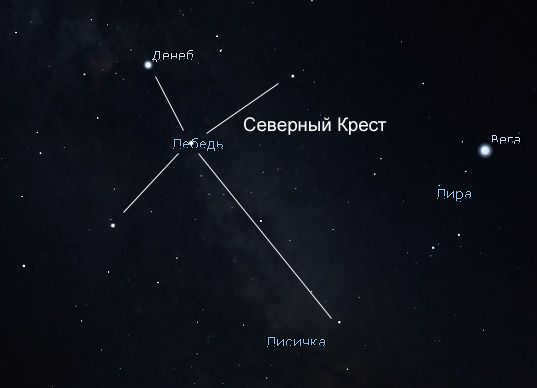
The primary constellation in which the Northern Cross is located is the Swan. Image Source: Stellarium
The main components of the cross are Deneb (alpha of Swan), Sadr (gamma of Swan), and Albireo (beta of Swan), while the crossbar is formed by the stars epsilon and delta of Swan.
Teapot
The Teapot is a well-known constellation in the night sky. It consists of a group of stars that form the shape of a teapot. This constellation is located within the constellation Sagittarius and can be easily identified by its distinctive shape. Take a look at the image below: doesn’t it resemble a teapot?
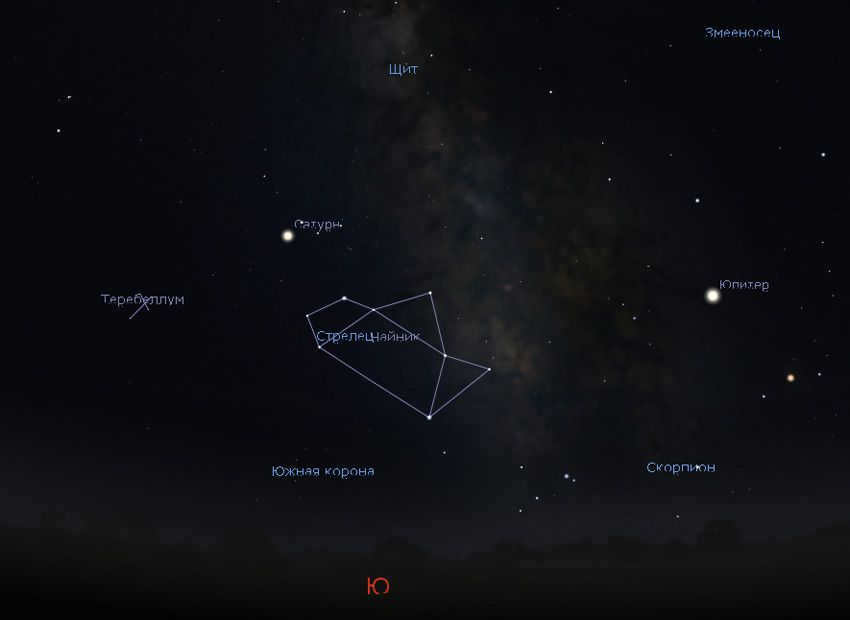
The constellation Sagittarius features a remarkable asterism known as the Teapot. This celestial formation, depicted in the figure above captured by Stellarium, is a stunning sight to behold. It is worth noting, however, that this captivating asterism can only be fully observed in the southern regions of Russia. Unfortunately, at latitudes such as Moscow and St. Petersburg, the “bottom” of the teapot never rises above the horizon.
When discussing the vast expanse of the northern hemisphere’s celestial sphere, one cannot overlook the prominent Big Bucket asterism. During the initial months of summer, the Big Dipper can be observed in the evening sky, positioned prominently above the western horizon. Notably, the dipper appears tilted – if it were brimming with water, it would undoubtedly overflow onto the Earth’s surface!
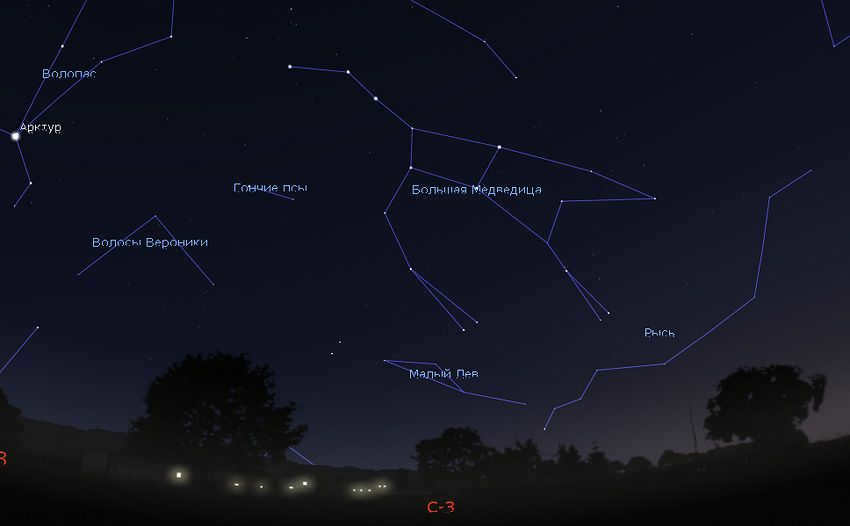
The Big Dipper can be observed in the northwestern part of the sky during summer evenings. Image: Stellarium
During the months of July and August, the Big Dipper can be seen in the northwest, positioned almost parallel to the horizon in its iconic shape.
By following the Big Dipper, you can locate various stars and constellations, including Arcturus and Capella, as well as the constellations of Cassiopeia, Leo, and Ursa Major, and the important North Star, Polaris. (Learn how to find Polaris using the stars of the Big Dipper here.)
Head of the Dragon
Returning to the most luminous celestial body in the Summer Triangle, Vega. During the summer months, Vega can be seen high above the southern horizon. Directly above Vega, positioned precisely at the zenith, we find the four stars that make up the Dragon constellation, forming an irregular quadrilateral. Among these four stars, the brightest one, known as the gamma star of the Dragon, is located closer to Vega than the others. In ancient cartography, this region was represented as the fire-breathing head of the mythical creature, and subsequently, these four stars became known as the Head of the Dragon. Dragon’s Head.
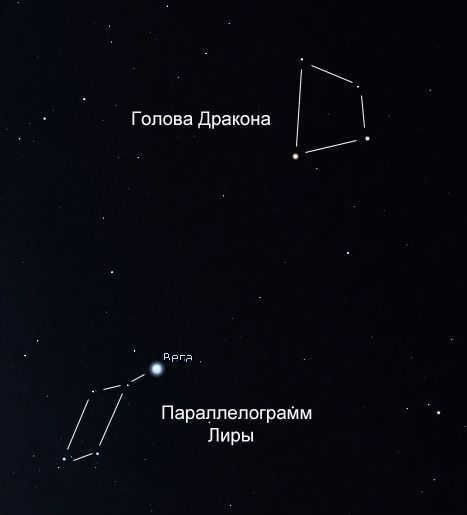
Above Vega, the brightest star in the Summer Triangle, you can find the Dragon’s Head. This asterism can be seen throughout the year – it reaches its highest point in the sky during the summer, moves towards the west in the fall, appears low above the northern horizon in winter, and finally, can be seen in the east during the spring. Starting from this asterism, you can easily locate the other stars of the Dragon constellation, which is a long and intricately curving constellation situated between the Big and Little Dippers.
One more well-known celestial object in the summer sky, called the Wedge, can be found to the right of Vega, along the line connecting Vega and Arcturus. This formation is a relatively large quadrilateral composed of stars with magnitudes 3 and 4, located in the constellation Hercules. On ancient maps, this quadrilateral represented the body, while the stars above and below it represented the arms and legs of the legendary hero.
Knowing the position of Klin is highly beneficial because along its right side lies the renowned globular star cluster M13, which is one of the most prominent globular clusters visible in our night sky.
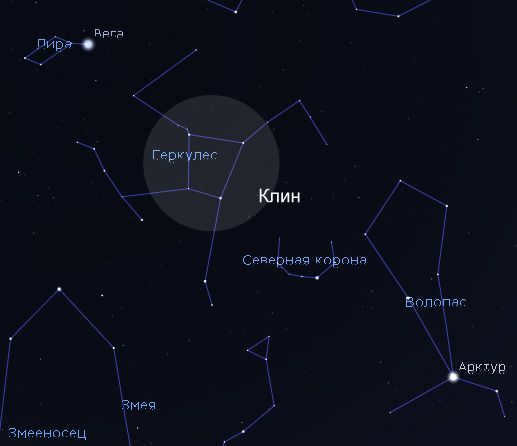
The asterism known as Cuneus or Cornerstone can be found in the Hercules constellation, positioned between Vega and Arcturus. This configuration can also be referred to as Keystone in the Western world.
Poniatowski’s Bull
In the northeastern part of the Serpentor constellation, there is a compact and beautiful group of stars. This group consists of 5 stars of 3rd and 4th magnitude, forming a Latin V shape in the sky. The resemblance to the Hyades pattern in the Taurus constellation is so striking that the asterism is named “bull”.
The Bull comprises the stars 66, 67, 68, 70, and 73 of the Serpentine.
It should be noted that originally, Poniatowski’s Bull was created as a separate constellation. It was invented in 1777 by Abbot Poszobut from Vilnius (then Vilna) and named after King Stanislaw Poniatowski of Poland. Despite receiving formal approval from the French Academy of Sciences, Poniatowski’s Bull did not gain popularity among astronomers and was soon forgotten.
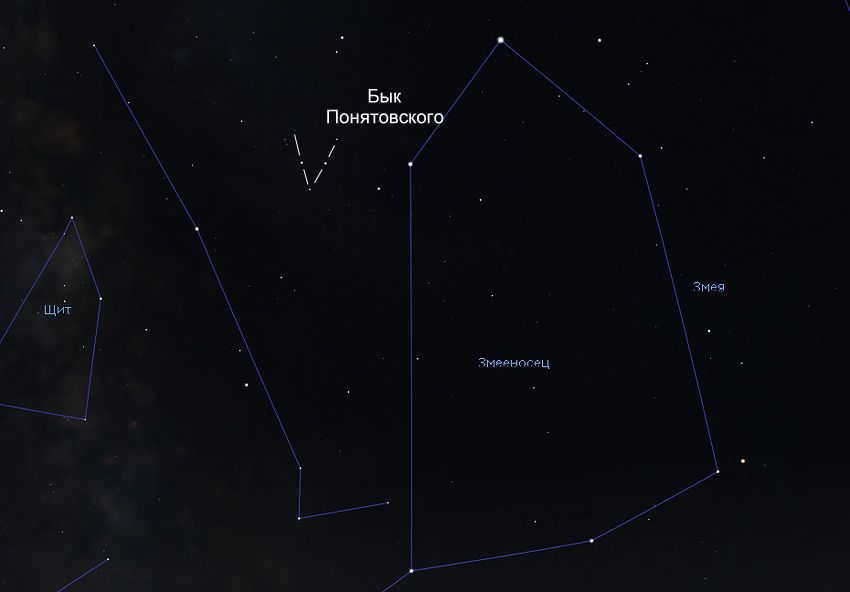

The celestial figure known as Poniatowski’s Bull can be found in the northeastern region of the Serpentor constellation. This stunning image was captured by Stellarium.
Delphinus rhombus
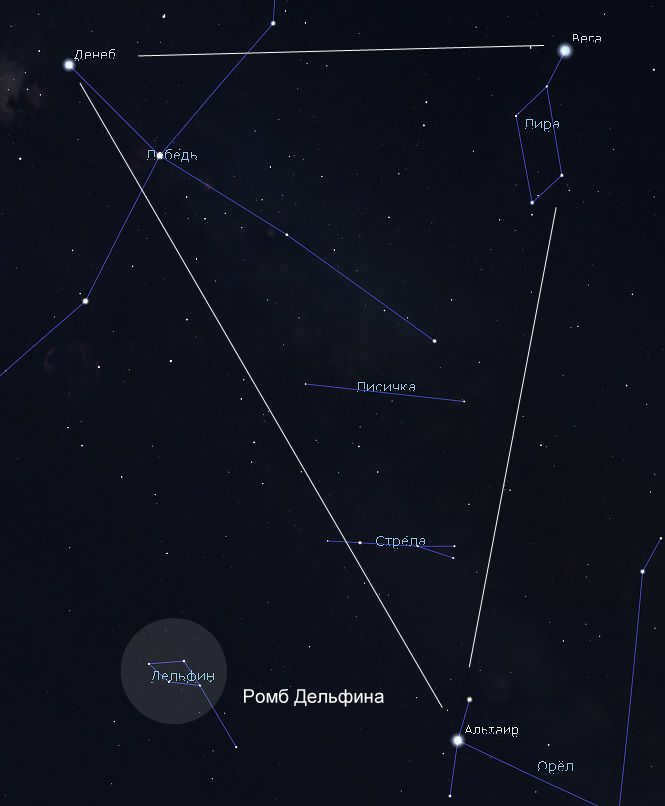
Dolphin Rhombus. Figure: Stellarium
Among the celestial formations that adorn the summer sky, there is a stunning asterism consisting of four 4th magnitude stars arranged in a small rhombus shape within the constellation Dolphin. According to the ancient Greeks, who were responsible for naming and creating this constellation, this rhombus represents the body of a mythical creature, while the two stars positioned below it depict its gracefully curved tail.
Adjacent to the Summer Triangle, this rhombus of stars in Delphinus can be found to the east, positioned above and to the left of the prominent star Altair.
The Hanger
The Hanger is the only telescopic asterism found in this small survey, and it originates from the Foxy constellation. Positioned to the south of the Albireo star from the Swan constellation and to the right of the Arrow constellation, this compact group of stars presents a breathtaking sight when observed through binoculars or a small telescope at low magnification.
A total of six stars with magnitudes ranging from 6th to 7th are perfectly aligned in a straight line, forming the base of this figure. Below them, three stars with a magnitude of 5th create the hook. It can be likened to a coat rack!
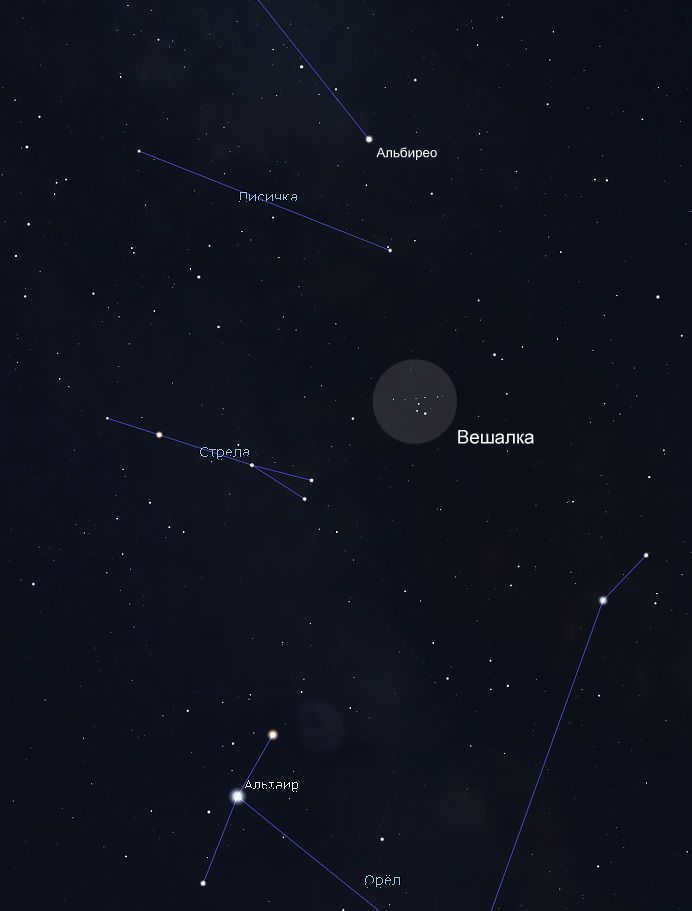
The asterism known as Hanger can be found situated between the star Albireo in the head of the Swan and Altair in the constellation Eagle. Image Source: Stellarium
There has been much debate among astronomers regarding whether this group of stars should be classified as a cluster or an asterism. It was difficult to fathom that these celestial bodies had congregated in a single area of the sky by mere chance, giving the appearance of being aligned along a single line of sight. However, the data on the distances to the stars in the Hanger asterism, obtained from the Hipparcos satellite, provided additional evidence supporting the theory that it is indeed an asterism rather than a cluster.
Indeed, there are numerous asterisms scattered across the celestial sphere. Each astronomy enthusiast has the opportunity to create their own unique asterism, inspired by a favorite constellation of stars. (Assuming it hasn’t already been named by another enthusiast!) Notably, there are many smaller, telescopic asterisms comprising of stars that are not visible to the naked eye. However, among these, only a handful are widely recognized by astronomy enthusiasts. Hence, I have refrained from listing them all in this piece.
If you have devised your own personal asterism, feel free to share it in the comments section!
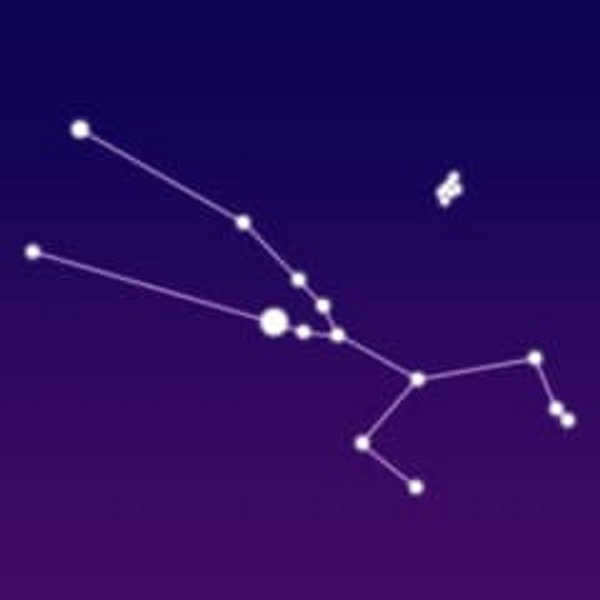
Taurus is a renowned and expansive constellation that holds a significant place in Greek mythology. It is closely linked to the story of Zeus, who transformed into a bull in order to abduct Europa. This constellation is notable for its abundance of bright stars, including the well-known Pleiades, also known as Messier 45. Notable celestial objects within Taurus include Messier 1, the variable nebula NGC 1555, the colliding galaxies NGC 1410 and NGC 1409, the nebula NGC 1514, and NGC 1435.
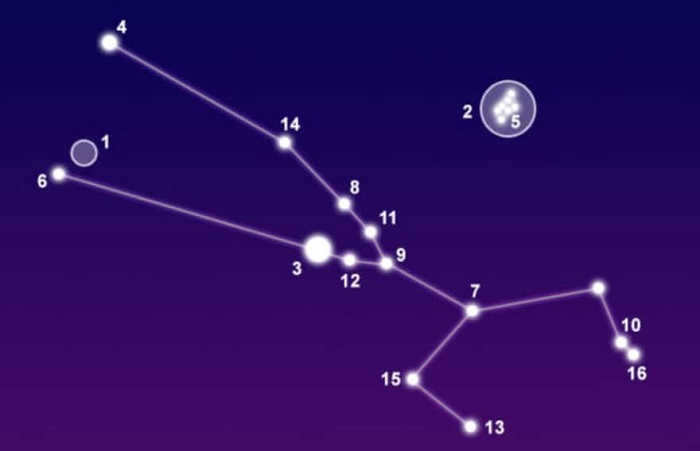
Facts, position and map
Taurus is the 17th largest constellation in size, covering an area of 797 square degrees. It occupies the first quadrant in the northern hemisphere (NQ1) and can be observed at latitudes ranging from +90° to -65°. Taurus is bordered by the constellations Aries, Whale, Eridanus, Gemini, Orion, Perseus, and Ascendant.
| Taurus | |
| Tau | |
| Bull | |
| 3 hours and 17 minutes to 5 hours and 53 minutes | |
| -1° 45′ to +30° 40′ | |
| 797 square degrees (ranked 17th) | |
| Aldebaran (α Tau) – 0.87m, Nat (β Tau) – 1.65m, Alcyone (η Tau) – 2.85m, ζ Tau – 2.97m | |
| Taurids, Beta Taurids | |
| Ascendant, Perseus, Aries, Cetus, Eridan, Orion, Gemini | |
| The Taurus constellation can be observed at latitudes ranging from +89° to -59°. The optimal time to observe it is during the months of November and December. | |
Within the Taurus constellation, there are two Messier objects (M1 and M45), along with five stars that have planets in orbit. The most luminous of these stars is Aldebaran (Alpha Taurus), with an apparent magnitude of 0.85. Aldebaran also holds the 13th position among all known stars. Noteworthy within this constellation are two meteor showers: the Taurids, occurring in November, and the Beta Taurids, which take place in June and July. Taurus is part of the Zodiac collection, which encompasses Aries, Gemini, Cancer, Leo, Virgo, Libra, Scorpio, Sagittarius, Capricorn, and Pisces. To gain a deeper understanding of the Taurus constellation, it is recommended to study a star map that depicts the diagram of this celestial formation.
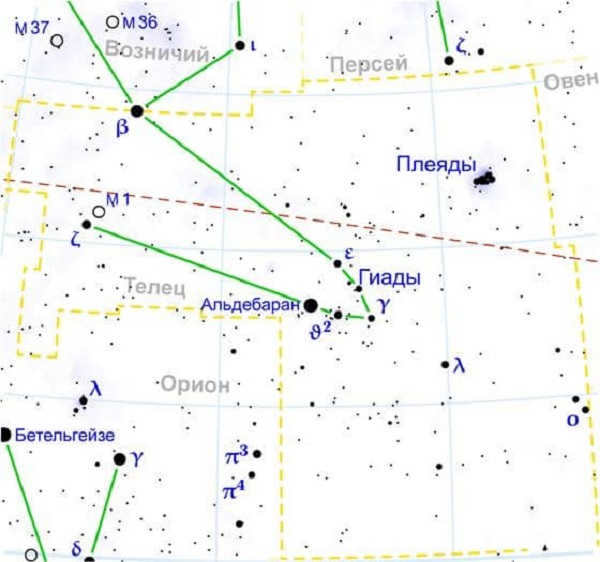
Legend
During the time of the Bronze Age, knowledge of Taurus already existed as it indicated the position of the Sun during the vernal equinox. Various cultures depicted the constellation as a bull. In fact, ancient rock art in Lascaux Cave (15,000 BC) showcases images of Taurus and the Pleiades. Taurus and the Pleiades held significance in numerous cultures, with references to them as the bull and the seven sisters.
According to Greek mythology, Zeus took on the form of a bull in order to abduct Europa, the daughter of Agenor. He disguised himself among the king’s herd and caught the girl’s attention with his remarkable beauty. Once Europa climbed onto his back, Zeus transported her to the island of Crete, where he revealed his true identity and showered her with gifts.
Europa and Zeus had three sons, including Minos, who became the king of Crete. Minos constructed a palace and organized bull games, during which he would sacrifice seven boys and girls to the Minotaur every year. Eventually, Zeus elevated the bull to the heavens.
Another legend involving Zeus revolves around Io, who was the mother of Europa. Io also fell victim to the god’s seduction. However, Hera, Zeus’ wife, suspected his infidelity and transformed Io into a cow to conceal her.
Notable celestial bodies
Discover the prominent stars found in the zodiacal grouping known as Taurus, complete with comprehensive explanations and classifications.
Aldebaran, also known as Alpha Taurus, is a colossal orange giant (K5III) boasting a visual magnitude range of 0.75-0.95 (making it the brightest star in Taurus and the 13th brightest in the entire sky). Situated approximately 65.1 light-years away, it measures a staggering 44.2 times the size of our Sun and shines 425 times more luminously. Furthermore, Aldebaran exhibits characteristics of a slow, unpredictable variable star, specifically categorized as a type LB, with its brightness fluctuating by 0.2 magnitudes.
The star can be found within the Orion constellation, so it is advisable to search near the three prominent stars that make up the Orion belt. Alternatively, you can also reference the Hyades cluster, as it serves as the most luminous star within it. However, it is important to note that the Hyades cluster is not part of the composition and is positioned on the line of sight (approximately 150 light years away from us).
Aldebaran is situated in close proximity to the ecliptic and may be obscured by the Moon.
Its traditional name, Aldebaran, originates from the Arabic term al-dabarān, meaning “follower”. This name was assigned to the star due to its apparent position behind the Pleiades.
Nat (Beta Taurus) is a massive star (B7III) with a brightness of 1.68 and a distance of 131 light-years. It is 700 times more luminous than the Sun and is located close to the ecliptic (which may coincide with the Moon). It can be found near the constellation of Ascendant, earning it the occasional nickname of Gamma of Ascendant (although this name is rarely used).
The name Nat is derived from the Arabic term an-naţħ, meaning “to bump” (in reference to the horns of a bull).
Zeta Taurus is a binary star system (B2 IIIpe) with a visual magnitude of 3.010 and a distance of 440 light-years. It has an orbital period of 133 days.
The primary component of Zeta Taurus rotates at a speed of 125 km/s and possesses a disk of gas surrounding it. It has a mass of 11 times that of the Sun and is 5-6 times larger in radius. The companion star has a lower mass than the Sun.
Theta Taurus is a binary star system and one of the members of the Hyades cluster. These celestial objects have an angular separation of 5.62 minutes. The first star is located at a distance of 154.4 light-years, while the second star is 150.4 light-years away.
Theta-1 is classified as an orange giant (K0 IIIb Fe-0.5) and is the fainter of the two objects, with a visual magnitude of 3.84. Theta-2, on the other hand, is a white giant (A7 III) and has an average apparent magnitude of 3.40. It is a variable star known as Delta Shield, which means its brightness varies from 3.35 to 3.42 with a period of 1.82 hours.
Lambda Taurus is a triple star system with a visual magnitude of 3.47 and a distance of 480 light-years. Its name, “Pectus Tauri,” is derived from Latin and translates to “bull’s chest.”
The primary focus of this system is a binary star system called Lambda AB, which consists of two stars that orbit each other with a period of 3.95 days. These stars create an eclipsing double star system, causing their combined apparent magnitude to vary between 3.37 and 3.91.
The first star in this system, known as the primary component (B3 V), has a mass of 7 solar masses and is 6.4 times larger in radius. It is also 5801 times brighter than our Sun. This star has a rotational velocity of 85 km/s. The second star, a subgiant (A4 IV), is 1.9 times more massive than the Sun and is 128 times brighter. It has a rotational speed of 76 km/s. The third object in this system has half the mass of our Sun and orbits the inner pair with a period of 33.025 days.
Epsilon Taurus is a type of star known as an orange giant (K0 III) and has a visual magnitude of 3.53. It is located approximately 147 light years away. Due to its position near the ecliptic, it occasionally becomes hidden by the Moon or other planets. There is also a companion star with a magnitude of 11 located about 182 arc seconds away. Epsilon Taurus is a member of the Hyades cluster and is estimated to be around 625 million years old.
In 2007, astronomers discovered an exoplanet orbiting Epsilon Taurus. This planet has an orbital period of 1.6 years and is the first known planet within an open cluster, specifically the Hyades cluster.
Epsilon Taurus is also known by two names, Ain and Oculus Borealis, both of which mean “eye”.
Another star in the Taurus constellation, Gamma Taurus, is a giant star (G8III) with a visual magnitude of 3.654. It is located about 154 light-years away. Gamma Taurus is estimated to be between 430 and 530 million years old. It is much larger than our Sun, with a radius 13.4 times greater and a brightness 85 times greater.
Xi Taurus is a system consisting of three blue-white dwarfs of the main sequence (B). It is characterized by being both a spectroscopic and eclipsing star system. Two of the stars within this system are in close proximity to each other, completing a revolution every 7.15 days. The third star orbits around these two in a longer period of 145 days.
The system has an average apparent visual magnitude of 3.73, with slight variations ranging from 3.70 to 3.79. It is located at a distance of 222 light years from us.
Delta Taurus is another system consisting of three star systems that can be found within the Hyades cluster. These star systems are also situated close to the ecliptic, which means they can occasionally be obscured by the presence of the Moon and planets.
Delta-1, also known as the Second Hyades, is a fascinating triple star system. It has an apparent visual magnitude of 3.77 and is located at a distance of 153 light-years from Earth. The main star in this system is an orange giant, classified as a K0 III. It is a whopping 74 times brighter than our Sun and has a radius that is 11.6 times larger. Quite impressive, isn’t it? Interestingly, Delta-1 has a companion star that is physically unbound and located 107 angular seconds away. This companion star has a magnitude of 12 and does not orbit Delta-1. Instead, it rotates on its own with a period of 530 days.
Delta-2, on the other hand, is a main-sequence dwarf star classified as an A7V. It has a visual magnitude of 4.80 and is located at a distance of 146 light-years. Interestingly, Delta-2 is located quite close to Delta-1, only 0.23 degrees away.
Delta-3 is a system of three stars positioned 0.72 degrees away from Delta-1. It has an apparent visual magnitude of 4.30 and is located 148 light-years away. The primary star is a subgiant that appears white and belongs to the A2IV spectral class. It displays variability of the Alpha-2 Hound Dog type, with its brightness changing from magnitude 4.29 to 4.32 every 57.25 days. The system also includes two satellites, one with a magnitude of 8 and the other with a magnitude of 11.
Kappa Taurus is a star system located at a distance of 148 light-years. The most prominent components of this system are two stars, both belonging to the A spectral class. One is a subgiant with a visual magnitude of 4.21, while the other is a dwarf with a magnitude of 5.27. These two stars appear as a visual binary and are separated by an angular distance of 5.8 arc minutes.
Between them is an additional binary star system, comprised of two stars with a magnitude of 9 and separated by a distance of 5.3 arc seconds. These stars are situated 183 seconds away from the brightest object in the system. Additionally, there are two other companions that have a magnitude of 12.
Taurus’ Ypsilon is a triple star and part of the Hyades cluster. It has an apparent visual magnitude of 4.28 and is located 155 light-years away.
The primary object is a main-sequence dwarf (A). It is a variable star of the Delta Shield type and its brightness changes from 4.28 to 4.31 every 3.56 hours. This star is also a spectroscopic binary with its components separated by 0.02 arc seconds. The third star is a magnitude 12 star positioned 110 arc seconds away from the binary pair.
119 Taurus is a red supergiant star (M2Iab-Ib) with a visual magnitude of 4.32 and a distance of 1.802 light-years. It is 600 times larger in diameter than the Sun and is recognized as one of the most prominent red stars, characterized by a color index of 2.07.
This star exhibits characteristics of a semiregular variable, with its brightness ranging from 4.23 to 4.54 over a period of 165 days. Due to its proximity to the ecliptic, there are instances when it becomes obscured by the Moon and other planets.
On the other hand, Rho Taurus is a white main-sequence star (A8V) located 152 light-years away. It has a visual magnitude of 4.65 and surpasses the mass of the Sun by a factor of 1.88. With a rotational velocity of 117 km/s, it completes one rotation every 488.5 days. This star is classified as a Delta Shield type variable, displaying a brightness fluctuation of 0.01 magnitude every 1.61 hours.
111 Taurus is a binary star system that emits X-ray radiation. It consists of two main-sequence stars, F8 V and K5 V. The combined apparent magnitude of the system is 5.1149, and it is located at a distance of 46.9 light-years.
Omicron Taurus, on the other hand, is a giant star of spectral type G6 III Fe-1. It has an apparent visual magnitude of 3.61 and is situated 212 light-years away. This star is also a binary system with an orbital period of 1655 days.
The axial rotation period of Omicron Taurus is 533 days. Compared to the Sun, it is 18 times larger in radius, three times more massive, and 155 times brighter.
Taurus T is a variable star that is considered the prototype for the Taurus variables. It was first observed by John Hynde in 1852 and is located in close proximity to Epsilon Taurus.
These stars are in the pre-main-sequence stage and have a mass at least twice that of the Sun. They belong to the spectral classes F, G, K, and M. Their larger radius makes them brighter than main-sequence stars. They are commonly found near molecular clouds and display optical variability and strong chromospheric lines.
The system consists of three stars. One is visible in optical wavelengths while the others can only be seen in infrared wavelengths. One of the stars emits radio waves.
T Taurus is located near the reflecting nebula NGC 1555 and illuminates it (the nebula also exhibits variations in brightness). The system has an apparent visual magnitude of 10.27 and is situated 600 light-years away from Earth.
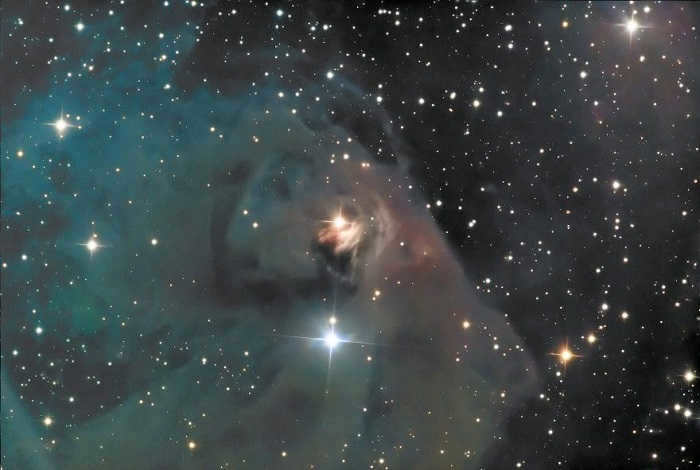
The Taurus constellation features a binary star system with a separation of 0.6″ (which is not depicted in the image). The objects surrounding the star are not satellites, but rather filter features. The western nebula (NGC 1555) is reflected by this star.
RV Taurus is a yellow supergiant (G2eIA-M2Ia) that exhibits variations in brightness, ranging from 9.5 to 13.5 magnitude, and is located at a distance of 7100 light-years. It serves as the prototype for a class of variable stars. Along with changes in luminosity, the star also undergoes spectral type transformations. It is classified as G2 at maximum luminosity and as M2 at minimum luminosity. The circumstellar disk surrounding the star is visible.
This pulsating variable star is approaching the end of its life cycle. Eventually, it will shed its outer layers, forming a planetary nebula and leaving behind a white dwarf.
Russian astronomer Lydia Serasky first observed the variability in brightness in 1905.
HD 37124 is a G4V yellow dwarf with an apparent visual magnitude of 7.68 and a distance of 110 light-years.
In 2005, three exoplanets were discovered, all of which are located within the habitable zone and none of which are hot Jupiters.
Alcyone (Eta Taurus) is a double system that eclipses each other. It has an apparent visual magnitude of 2.873 and a distance of 370 light-years. It is the third brightest star in the system and the brightest star in the Pleiades cluster. The two objects are separated by 0.031 arc seconds.
The primary celestial body is a massive blue-white star (B7IIIe) with a visual magnitude of 2.87. It has a radius 10 times greater than that of the sun and shines 2400 times brighter. Additionally, it spins at a velocity of 215 km/s and possesses a gas disk located at its equator.
The secondary star is comprised of three components, B, C, and D. The first two are white dwarfs (A) with an 8th magnitude, while D is a yellow-white dwarf (F). C is also a variable Delta Shield star, exhibiting fluctuations in brightness from 8.25 to 8.30 every 1.13 hours.
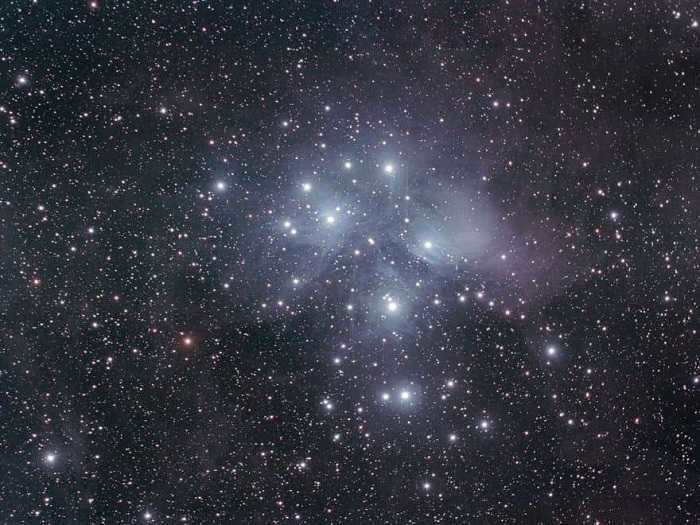
Atlas (27 Taurus) is a stellar trio with a brightness level of 3.62 and a distance of 381 light-years. It acquired its moniker from Titan (the progenitor of the Pleiades).
The primary entity is a massive blue-white star (B8 III). It comprises a dual system that can be observed through spectroscopy, with constituents possessing magnitudes of 4.1 and 5.6. The orbital cycle lasts for 1250 days. Positioned 0.4 arc seconds away is a faint companion with a visible magnitude of 6.8.
Electra (17 Taurus) is a massive blue-white star (B6 IIIe) that appears with a visual magnitude of 3.705 (the third brightest in the cluster) and is located approximately 600 light-years away. The star rotates at a speed of 181 km/s, causing it to become flattened at the poles and elongated at the equator. The presence of an infrared excess suggests the presence of a gas disk surrounding the star, formed due to the loss of mass resulting from its rapid rotation. Occasionally, the star may be obscured by the Moon or planets.
Maya (20 Taurus) is a bright blue star (B8III) with a visual magnitude of 3.871 and a distance of 360 light-years. It is one of the stars within the Maya Nebula (NGC 1432).
The star is characterized by its mercury-manganese composition and unique chemical properties, which result in a distinct spectral line caused by the absorption of ionized mercury. In terms of its physical attributes, it is four times more massive than our Sun, has a radius that is 5.5 times larger, and shines with a brightness that is 660 times more intense.
Merope (also known as 23 Taurus) is a subgiant star of a blue-white hue, classified as a B6IVe. It has a visual magnitude of 4.113 and is located approximately 360 light-years away. With a mass equivalent to 4.5 times that of the Sun, Merope has a radius four times larger and shines with a brightness that is 630 times greater. Additionally, it exhibits variability in its brightness, displaying a fluctuation of 0.01 magnitude, characteristic of a Beta Cepheus-type variable star.
Notably, Merope is surrounded by the Merope Nebula, and currently, the Pleiades cluster is traversing through this nebula.
Taygeta (19 Taurus) is a system of three stars located at a distance of 440 light-years, with an apparent visual magnitude of 4.30. The primary star, known as A, is a spectroscopic double star. It is a subgiant of a blue-white color (B6IV), with its components having magnitudes of 4.6 and 6.1, separated by 0.012 arc seconds. The orbital period of this system is 1313 days. Additionally, there is a companion star of magnitude 8, which can be seen at a separation of 69 arc seconds.
Pleione (28 Taurus, BU Taurus) is another double star, classified as a B8Ivpe star, with a visual magnitude of 5.048. It is located at a distance of 392 light-years. Due to its proximity to the bright Atlas, it can be challenging to observe.
Pleione is categorized as a hot B-class star and is a classical Ve star, exhibiting hydrogen emission lines in its spectrum. It is 190 times brighter than the Sun. Additionally, it is a variable star of the Gamma Cassiopeia type, showing variations in brightness from 4.8 to 5.5.
Celeno (16 Taurus) is a blue-white subgiant (B7IV) with an apparent visual magnitude of 5.448 and a distance of 430 light-years. Known as the “Lost Pleiades” due to its elusive nature. It is larger than the sun, with a radius four times greater, and has a rotation speed of -185 km/s.
Asteropa (21 and 22 Taurus) consists of two stars separated by 0.04° and located 440 light-years away from our solar system. 21 Taurus is a main-sequence dwarf (B8 V) with an apparent magnitude of 5.76. On the other hand, 22 Taurus is a main-sequence dwarf (A0Vn) with an apparent magnitude of 6.43.
Celestial bodies
The Crab Nebula (Messier 1, M1, NGC 1952) is a remnant of a supernova and a nebula powered by the wind of a pulsar located in the remnants of a supernova.
A pulsar is a highly magnetized rotating neutron star that emits a stream of electromagnetic radiation.
Messier 1 has a visible magnitude of 8.4 and is located 6,500 light-years away. It has a diameter of 11 light-years and is expanding at a rate of 1500 km/s. It was discovered by John Bevis in 1731 and was included as the first object in the Messier catalog in 1758.
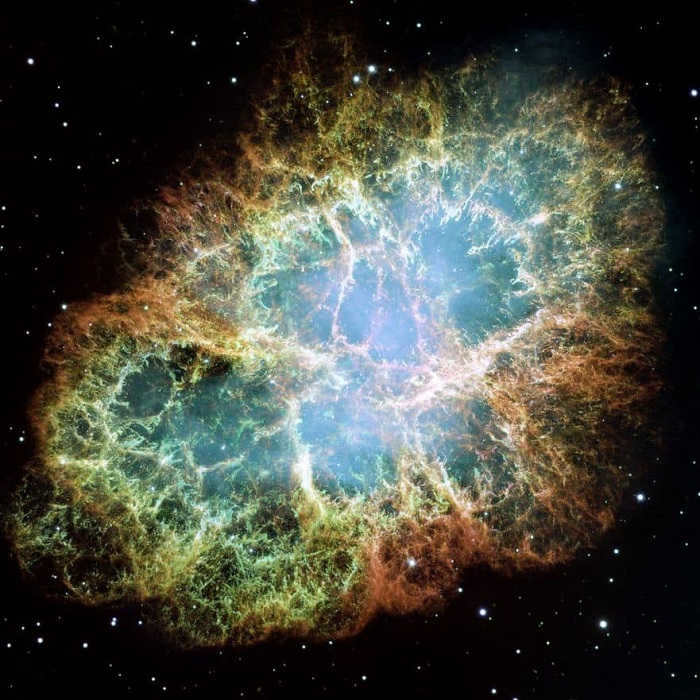
The Crab Nebula, as captured by the Hubble telescope, showcases its largest image yet. Within the image, the remnants of a hydrogen star are displayed as vibrant orange filaments. At the center of the nebula, a rapidly rotating neutron star emits a bluish light, with the electrons circling the star’s magnetic field lines at nearly the speed of light. This phenomenon can be likened to a lighthouse, emitting two beams of pulse-like radiation 30 times per second due to the star’s rotation. Neutron stars are the incredibly dense cores left behind after a star explodes, and the Crab Nebula earned its name from a drawing by Lord Rosset in 1844, which resembled a crab-like shape. Thanks to modern telescopes, we are able to conduct detailed studies of stars that are situated a staggering 6500 light-years away.
The Pleiades (Messier 45) is a star cluster that has been discovered. It is made up of hot, luminous stars (B) that have mostly formed within the last 100 million years. This cluster is widely known and can be easily located in the sky due to its proximity and high brightness.
With a visible visual magnitude of 1.6, the Pleiades spans 110 arc minutes in size. These stars are situated at a distance of 390-460 light years from our solar system.
The Pleiades cluster is expected to exist for another 250 million years, during which time interactions with neighboring objects will cause the stars to disperse. These stars are physically connected and share the same proper motion.
The Pleiades, a group of seven sisters in Greek mythology, have had the nine brightest stars in the constellation named after them. As the legend goes, Atlas was burdened with the task of holding up the heavens on his shoulders, while Orion started to pursue the Pleiades. In order to safeguard them, Zeus transformed the sisters into doves and later into stars. Interestingly, Orion continues to chase the Pleiades across the sky. The cluster itself is believed to have been mentioned as far back as the Bronze Age.
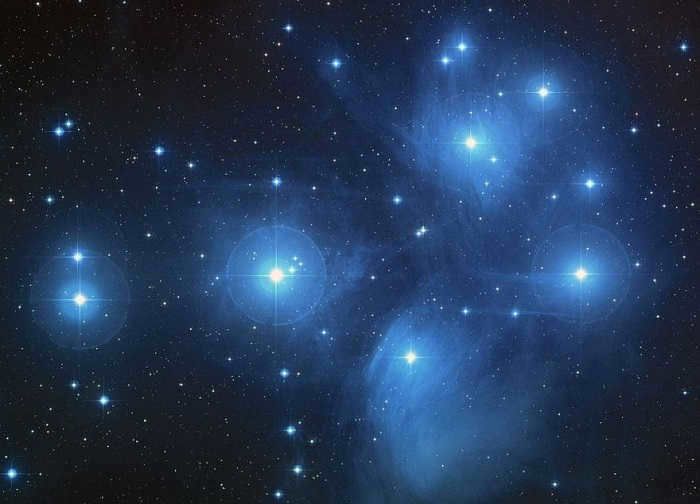
The Hyades cluster, also known as Caldwell 41, Melotte 25, and Collinder 50, is a collection of hundreds of stars that share common characteristics such as motion, origin, age, and chemical composition. As the closest star cluster to the Sun, it has been extensively studied. The cluster is estimated to be around 625 million years old and has an apparent magnitude of 0.5. It is located approximately 153 light-years away from Earth. The core of the cluster is densely populated with stars and has a diameter of 17.6 light-years.
Among the stars in the cluster, the brightest ones form a distinctive “V” shape. However, it is important to note that the star Aldebaran, although appearing in the same line of sight, is not actually part of the Hyades cluster.
The Hyades cluster was bestowed with its name as a tribute to the five daughters of Atlas, who were also the half-sisters of the Pleiades.
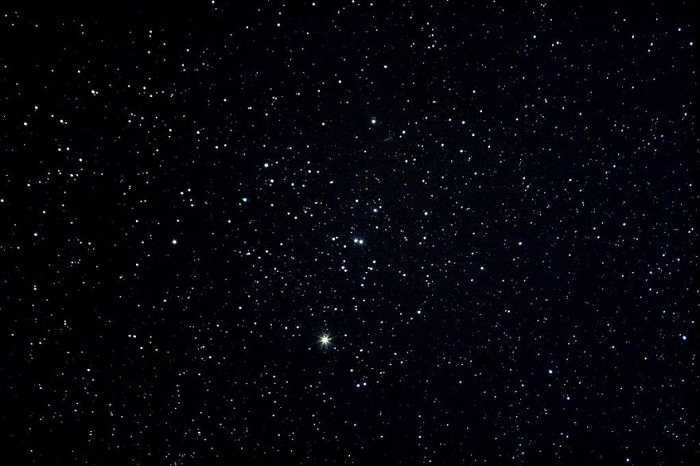
NGC 1555, also known as the Hynde Variable Nebula, is a stunning reflection nebula that exhibits variations in luminosity as a result of fluctuations in the brightness of the stars it is associated with. Situated in close proximity to the Taurus constellation, this nebula is illuminated by the radiant light emitted from these stars. Discovered on October 11, 1852, by the esteemed astronomer John Hynde, the Hynde Variable Nebula remains a captivating celestial wonder.
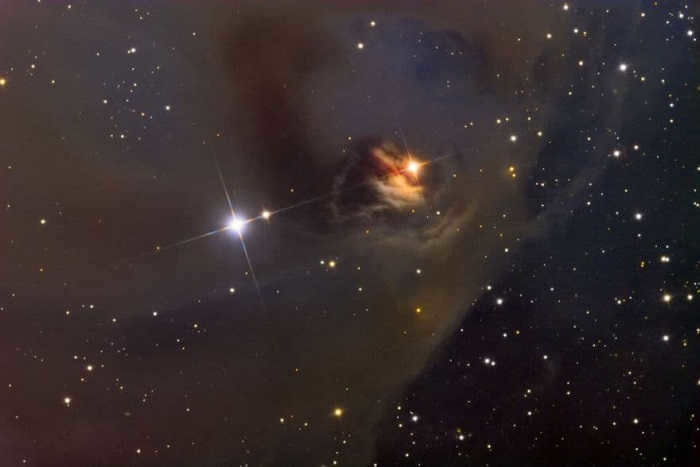
NGC 1410 and NGC 1409
NGC 1409 (on the right) and NGC 1410 (on the left) are galaxies in the process of colliding. They are connected by a gas arc that stretches 20,000 light-years across. NGC 1410 is the larger galaxy and is currently experiencing active star formation, while NGC 1409 has fewer young blue stars.
With an apparent visual magnitude of 15.4 and a distance of 300 million light-years, these galaxies are gravitationally bound and will eventually merge into a single object.
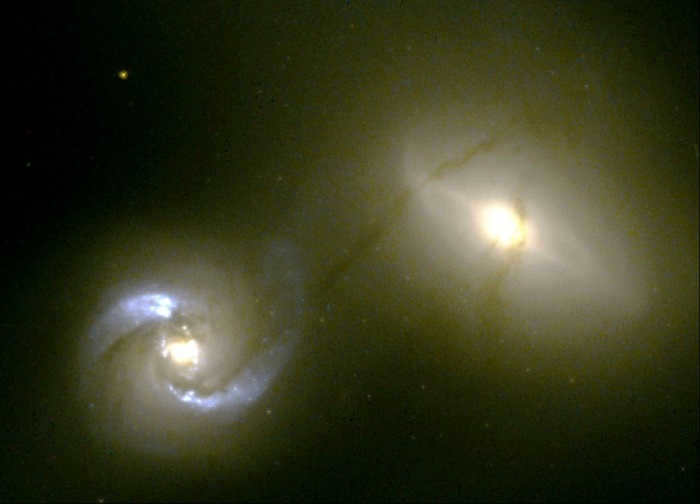
NGC 1409 and NGC 1410 exhibit a cosmic “pipeline” of matter streaming between two colliding galaxies approximately 100 million years ago. This pipeline, which is a shadowy filament of substance, originates in NGC 1410 (on the left), traverses over 20,000 light-years of intergalactic space, and wraps around NGC 1409 (on the right). While astronomers have captured numerous awe-inspiring images of galaxies colliding, this particular image provides the most distinct depiction of how certain interacting galaxies transfer material to one another.
The Crystal Ball Nebula (NGC 1514) is a sizable planetary nebula with an apparent visual magnitude of 9.43. It is believed to envelop a nearby binary star system that completes an orbit every 10 days.
It was first observed by William Herschel in November 1790.
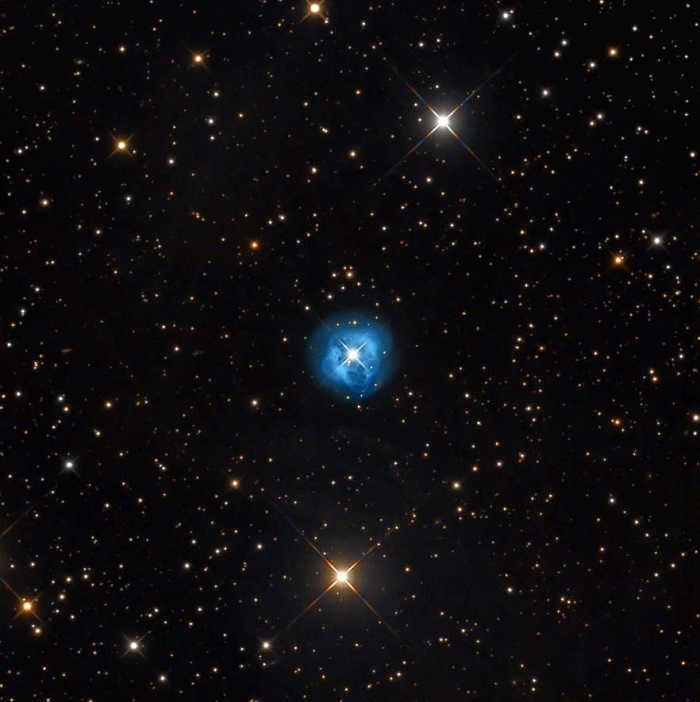
NGC 1746 is a group of stars or open cluster that has a brightness of 6.1 and spans 42 arc minutes. It was discovered in 1863 by Henry Louis D’Arré.
The Merope Nebula (NGC 1435) is a hazy reflection nebula situated within the Pleiades cluster and encompasses the star Merope (23 Taurus). It is believed to be the remnants of a supernova explosion.
It also surrounds IC 349, a luminous nebula that is located 0.06 light-years away from Merope.
NGC 1435 was identified by Wilhelm Tempel, a German astronomer. It has an apparent visual magnitude of 13.0 and is located 440 light-years away.
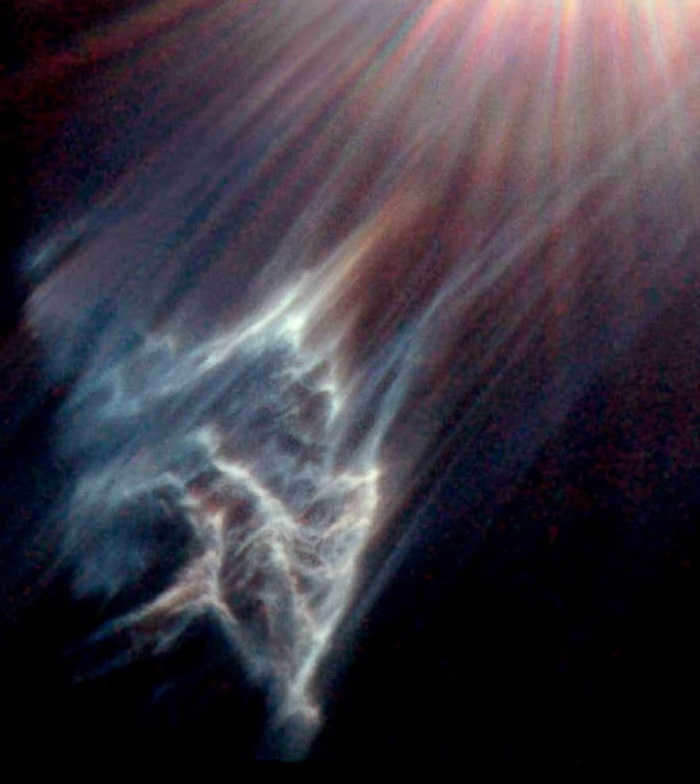
NGC 1647, situated amidst the horns of the iconic Taurus constellation, is an open cluster with an apparent visual magnitude of 6.4.
